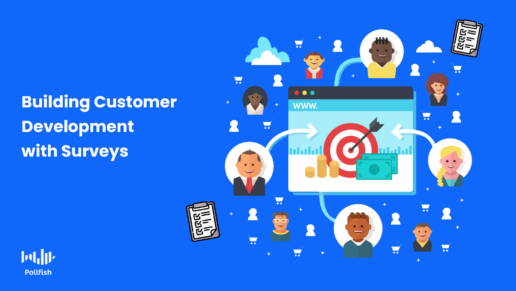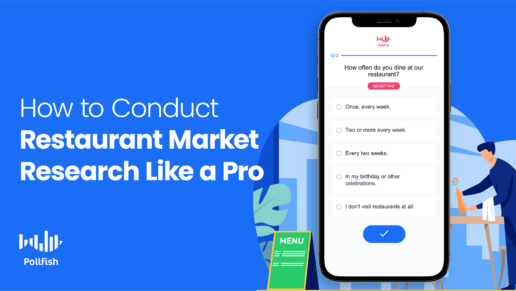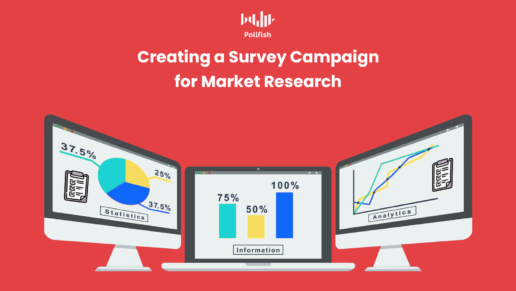How Surveys Foster and Improve Customer Development
How Surveys Foster and Improve Customer Development
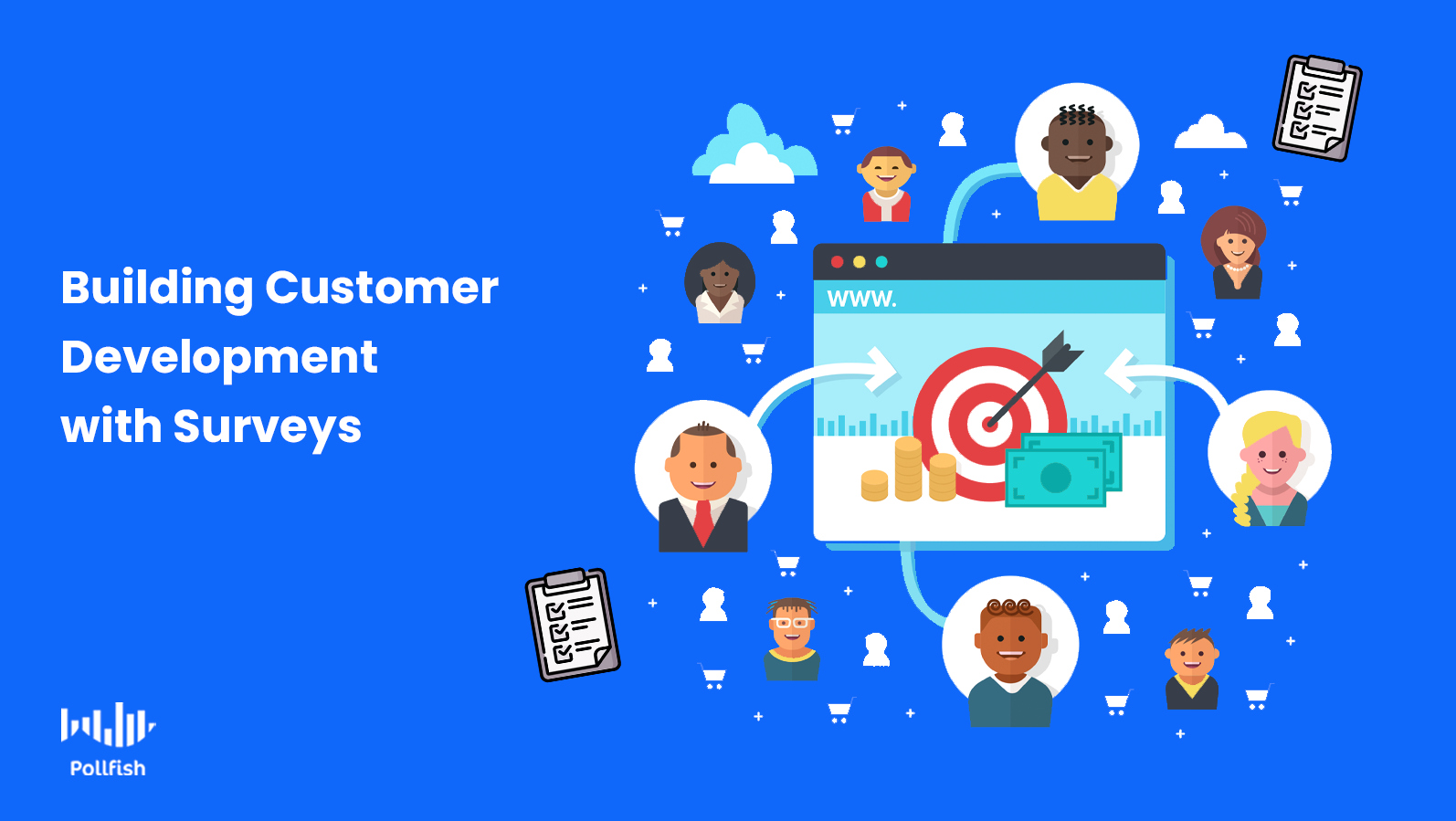
Customer development is a specialized method designed to satisfy your customers, a critical need for your business, especially in times of uncertainty.
Specifically aimed at startups, this framework was developed as a part of the Lean Startup methodology, a product development process bent on experimentation, repeated product releases and customer feedback, or VoC.
Customer development ensures that businesses understand market needs before launching a product, allowing them to foster and maintain product satisfaction. As such, all businesses, startups or not can benefit from understanding how to conduct this methodology.
Aside from providing key insights on the general market, surveys can help you attain product development so that you shorten the product development cycle and appease customers.
This article delves into the practice of customer development and expounds on how surveys can both foster and perfect the customer development process.
Defining Customer Development
Customer Development is a structure used to ascertain whether a product satisfies the need(s) of a target market. This framework is part of the lean startup concept, which dictates how startups must form and be managed, in order to bring a product to market more efficiently and grow at scale.
Conceived by entrepreneur Steve Blank, customer development is the mid-portion of the lean startup model, designed specifically to tackle the problem found within product development. As such, it requires to first fully evaluate the product opportunity and then prove that the solution proposed will, in fact, meet market demand and customer needs.
This framework was produced specifically for startups, as Blank observed that startups are not merely smaller versions of more established businesses. Instead, they require their own adapted approach.
As such, the customer development concept was conceived, running counter to traditional product development. Instead, it aims to test if a product will be viable for its target market via the lens of customer demand.
The 4 Steps of Customer Development
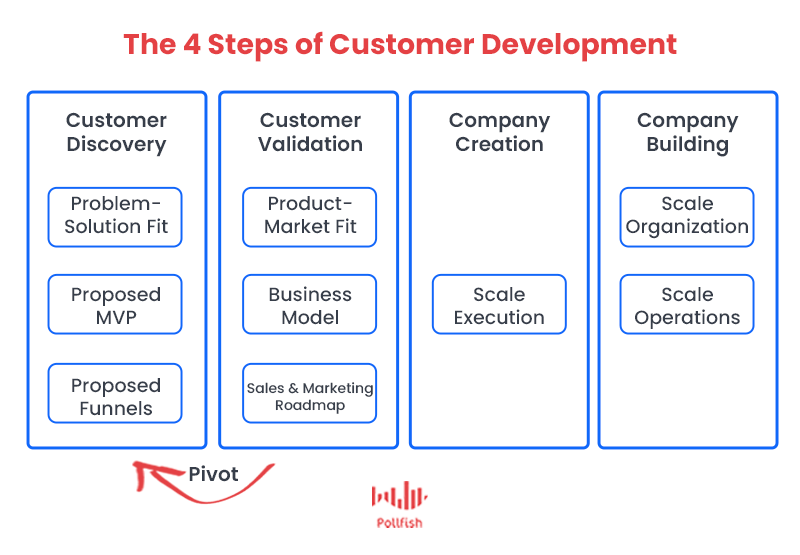
- Customer discovery: This is underpinned by understanding your customers and their needs, specifically the kinds that your product/service may be able to fulfill.
- Instead of starting with a hypothesis, customer discovery is set on finding how to make a proposed product/ service best serve customer needs.
- This involves putting together a business strategy and then testing two hypotheses:
- The problem hypothesis: your understanding of customer pain points
- The product hypothesis: your solution to these pain points
- Gain feedback on customer needs, pain points and attitudes on existing or similar products.
- Customer validation: You gain validation via selling your product, after your target market approves of it from Step 1.
- Form an iterative sales process, one bent on scaling. This involves selling to “earlyvangelists,” the customer segment that quickly understands the need for your product.
- Create a business model for the product, using the insights from Step 1. Include value propositions, product positioning and sales collateral.
- Company creation: Work on increasing your demand in this growth strategy stage.
- This stage typically already has an established demand for your product; as such, determine how to heighten the demand.
- It’s crucial to keep gathering customer feedback, conducting market research and using the knowledge you’ve gained to adapt your product.
- This is not an exploratory phase; rather it deals with maintaining your demand retaining customers.
- Company building: Continue supporting the growth of your business.
- This step includes defining the need for certain roles, developing more business departments and hiring more employees as a means of scaling.
- Not every startup will reach this stage, as it is a signifier of company success and a transition from a fledgling business to a full-fledged company.
- Achieving this stage may require redoing the customer validation or creation steps.
The Departments Involved in Customer Development
Although the product team is primarily involved, this is a cross-functional practice. Therefore, it involves a wide range of departments and sub-departments. This includes engineering, marketing, sales and product marketing.
When it comes to understanding the target market, reaching out to it and extracting its opinions, the most fitting teams are the marketing and product teams, as they are largely involved in appealing to the public. Their prowess hinges on talking to existing customers and gaining new ones, so they are the most suitable for outreach.
Additionally, many kinds of martech — software made particularly for marketing, are available to this team for gaining customer data. They can consolidate the data derived from martech, along with other forms of outreach when forming the basis for market needs.
Despite seldom involvement in customer interactions, founders, executives and C-level employees should also take part in this methodology. Their decisions often hold the most weight, and for good reason, as they have the experience and authority to make decisions that steer a business to success. As such, they should work in tandem with the other departments.
The members of higher-up teams must be open to findings and ideas that challenge their own beliefs and hypotheses, as market demand ultimately comes from the customers. Not all executives and founders will see eye to eye with customers, especially when certain target markets are more inclined to change their opinions.
They will have to cooperate with the other departments and leave their egos at the door in order to ensure successful approaches, accurate findings and data-based decisions,
Why Customer Development is Important for Business
This structure is crucial for businesses when it comes to bringing new products and services to market. While it is particular to startups with untested new products, businesses of other sizes and scopes can benefit from executing customer development.
This framework primarily allows businesses to validate the market demand — and to a significant extent — the success of a new product or business idea. It proves or disproves the viability of a new product, which is invaluable.
This is because investing in new solutions is often costly, time-consuming and laborious. It would be a colossal waste of time and money to invest in a product that evokes little to no market demand, especially from your target market, the customers most likely to buy from you.
Thus, customer development protects businesses from investing their resources into unvalidated or unproven products or product ideas.
In addition to this, this methodology helps prove that the product will, indeed, be of use to the customers. These insights help startups or even established companies discover which products are justified to produce and deploy, which require more customer opinions and which to completely disregard.
This process also helps weed out any opinion or intuition a business has, leaving emotions out of key decision-making steps, given that data takes the reigns.
Moreover, performing customer development produces a favorable fundraising outlook for a business. This is because it shows possible investors that the company has performed the necessary steps in validating a product launch. This is especially necessary for startups, which face a larger risk of failing and have less capital than an established business.
After all, investors will seek out stable products, those with a promising chance of profit, rather than products with no proven viability.
Finally, this methodology grants businesses the knowledge that allows them to make prioritizations. By understanding the needs of a target market, a business can produce only the most sought-after products and services, rather than venturing into every possible need its target market has.
How Surveys Help Customer Development
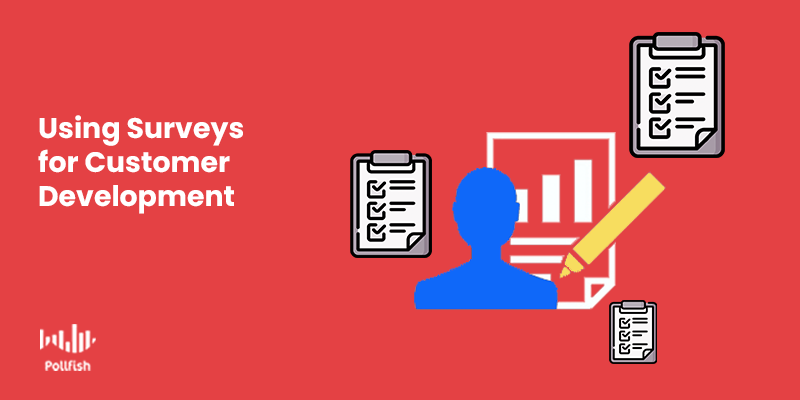
Surveys are necessary to use when taking part in the customer development process, as they not only bolster the process. Rather, they serve as the essential tools for gathering customer feedback, made possible through various kinds of consumer surveys.
They are essential in that customer development is founded on the basis of asking customers and potential customers, i.e., the target market, various questions on their needs, desires, pain points and opinions as they relate to your product or solution.
While it certainly is possible to use focus groups and conduct phone interviews, surveys present a far more efficient solution in gathering feedback. This is because they can be deployed to the masses and obtain responses in a relatively short amount of time (think several days as the maximum).
What’s more is that surveys ensure that you are only obtaining answers from those in your target market. They are granular, as you can target segments of your target market, as well as target respondents based on their responses to screening questions.
Surveys allow you to gain valuable insight through open-ended questions, which, in turn, allows you to derive key insights on how your product idea is viewed and gauge the need for it. As such, these insights are critical for Steps 1 and 2.
However, you can continue strengthening your market research in later steps as well, by applying surrey research, along with other primary research methods. Most importantly, surveys allow you to bypass using other primary sources, as you can ask virtually anything in your surveys to justify product development.
Scaling Your Startup & Business with Continuous Insights
Every startup needs to conduct customer development in order to assure a viable and efficient product launch. Even seasoned businesses can stand to implement this process, as it forgoes unvalidated opinions, the kinds that can set a business up for failure.
Instead, it concentrates on gathering customer information and key insights on market demand, which in turn can confirm speculations and justify new products. Much like its broader lean startup methodology, it grants businesses a formulaic approach to produce and deploy new products and solutions.
Given that surveys are a key component in the process, especially in regards to gaining actionable insights, an agile survey platform is a must. Any errors occurring in the survey process will taint the results, essentially making them biased, void and useless.
To avoid this major inconvenience and waste of time (something that surveys are supposed to save), a business must use an adept online survey tool, the kind that offers ease of question-building, targeting and deployment.
How to Conduct Restaurant Market Research Like A Pro
How to Conduct Restaurant Market Research Like A Pro
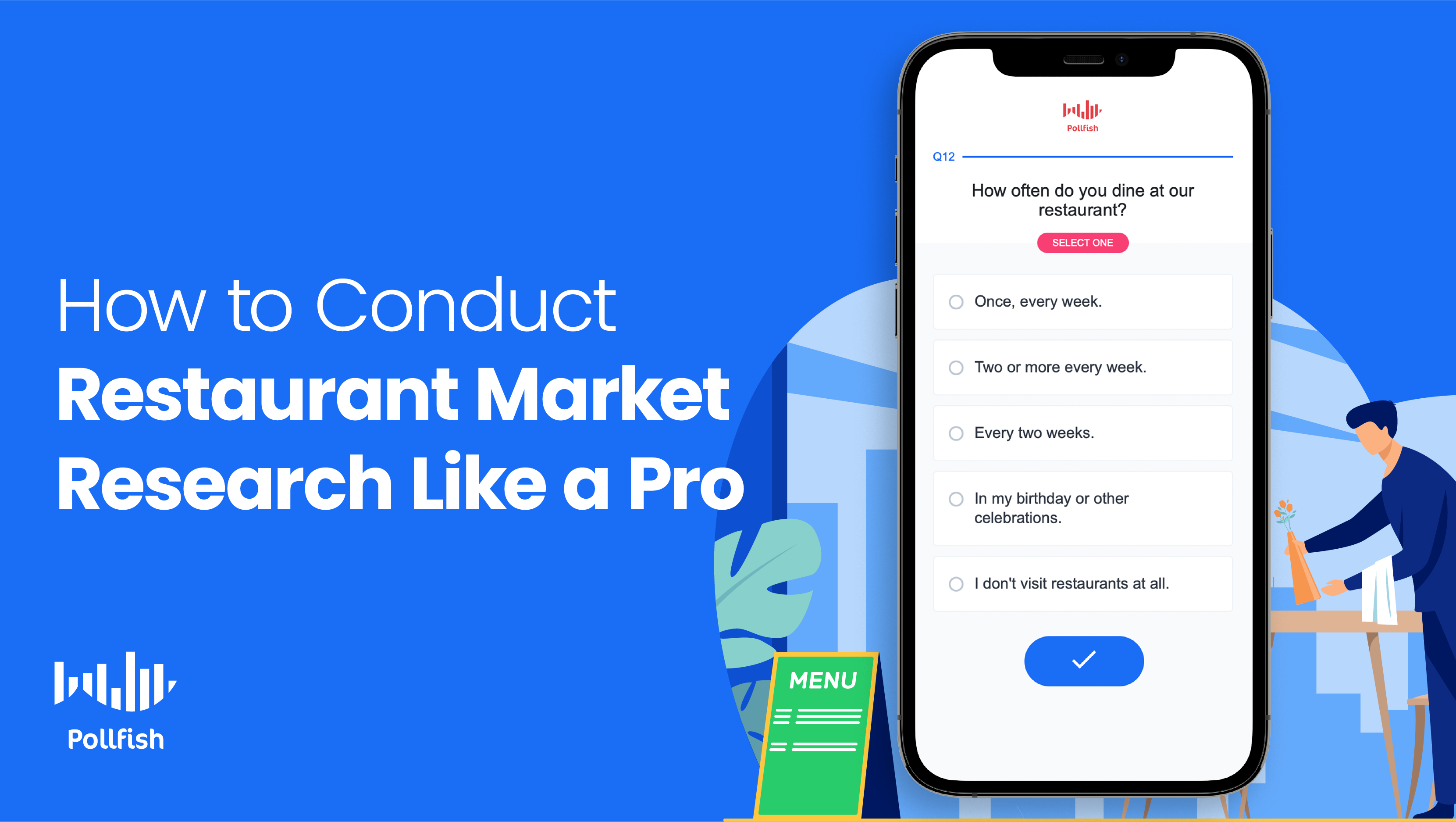
Restaurateurs, cafe owners, and eatery purveyors must conduct restaurant market research, as it is a highly competitive restaurant industry. Given that the industry is dominated by changing customer habits, businesses need to conduct thorough research to uncover potential opportunities.
As new restaurants open every day, the competition also increases. To stand out from this competition and ensure that prospective buyers know about their brand, restaurants must find strategies that enhance customer experience and content marketing strategy and advertising.
That usually involves an in-depth analysis of their customer preferences and an understanding of their competitors, neither of which is possible without restaurant market research. This article explains how restaurant owners can research their target market to ensure continued success, along with what market research means for the restaurants and the benefits of adopting these strategies.
The Growing Demand For Restaurants
Covid-19 had a devastating impact on the restaurant industry, as it hit the global hospitality businesses with brute force, compelling a complete ban on indoor dining leading to reduced sales.
But with lifted restrictions in the U.S., the restaurant industry is slowly getting on track. There’s an increase in demand for in-person dining, which means that the restaurant industry is on the road to recovery, making this the perfect time to open a restaurant. But before that, restaurant owners need to conduct in-depth market research.
Reasons To Conduct Restaurant Market Research
Restaurant market research is essential for restaurant businesses and entrepreneurs to understand the latest market trends, identify consumer pain points and target exactly what the consumers are looking for. It is one of the simplest and most effective ways of maintaining a competitive edge.
The following are some reasons why businesses need to conduct restaurant market research:
1. Identifying the Target Market
Conducting restaurant market research enables restaurants to determine the key demographics of their potential new customers. There are three different types of customers that most new businesses will encounter. Adequate market research will offer valuable insights into targeting each of these customers to adapt to their needs and turn them into loyal customers.
The 'Savvy' Purchasers
These are customers that are most interested in an A-class customer experience. They do not necessarily care about the quality of the product but rather how the business treats its customers. Restaurants need to identify these customers through secondary market research and price their products competitively.
The Industry Influencer
Industry influencers are primarily concerned with the quality of the product. They do not care whether the product is too expensive, as long as it provides valuable service and offers them satisfaction. Restaurant businesses need to know who the industry influencers are because they can bring in other prospective customers and inspire people to buy from their company.
The End-User
End-user customers are those that will become the restaurant’s regular, loyal customers. It's necessary to identify these customers as they can provide valuable information on the frustrations or limitations of the business. As such, end-users make ideal primary research candidates since they can help restaurant businesses gain a competitive edge.
2. Analyzing the Effect Of Competition
Restaurant market research also helps restaurant owners to see how other restaurants in the area are operating to develop unique strategies to get an edge over them. The restaurant industry is competitive, so opening a new restaurant will only be successful if it has a unique approach that helps it stand out from the crowd. For example, restaurant owners need to research what restaurants serve food similar to them and what strategies they employ to attract their customers.
Choosing an appropriate location for the restaurant is also essential. For example, if it’s a family dine-in restaurant, restaurant owners need to choose a residential complex with a higher percentage of families with children. They need to avoid opening the restaurant in a location where there is already an established restaurant chain.
Market research will also help business owners identify and analyze the strengths and weaknesses of their competitors. They need to look for loopholes in their services and strive to avoid them in their restaurant.
3. Uncovering Revenue Opportunities
A restaurant market analysis offers insights into untapped opportunities that businesses can leverage to maximize their revenue. A comprehensive market analysis can help them understand industry needs better and can narrow the kind of opportunities they are looking for.
For example, it can help the restaurants understand how to grow their business during seasonal events like Easter or Christmas. Companies can maximize their reach during specific seasons by offering promotional offers and unique menu items popular among customers.
4. Solving Business Challenges
One of the main problems affecting new restaurant owners is coming up with immediate solutions to problems. Many issues that arise require significant changes in restaurant strategies that can disrupt their operations.
To ensure successful restaurant operations, they need to ask themselves what their restaurant is doing differently from its competitors. They need to analyze their competitor’s business loopholes to identify any potential problems they might face later in the business.
Being aware of such issues and taking necessary precautions can help business owners devise the strategies required to overcome them.
5. Setting Targets For Their Restaurant Business
With actionable data and insights on their target customer base, restaurant businesses can set goals for the growth and improvement of their business.
Whether they want to establish a particular niche for their restaurant or introduce a special menu, market data enables them to set achievable targets.
How To Conduct Restaurant Market Research
The following are two popular methods of conducting this kind of research:
Using Primary Market Research Methods For Restaurants
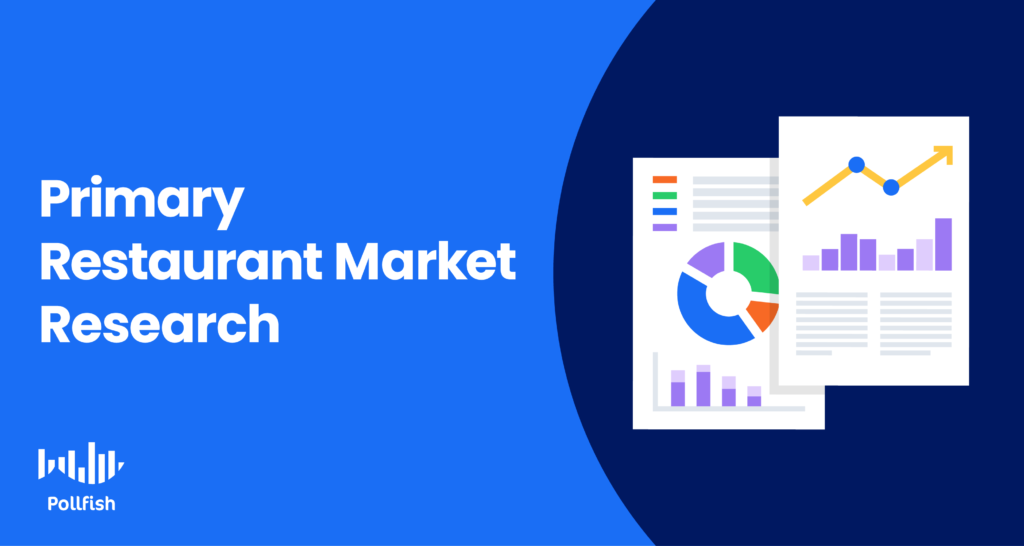
- Competitive assessments enable restaurant businesses to see how their competitors perform and identify gaps that their restaurants can fill in the market.
- Focus groups allow restaurant owners to connect with their target audience by inviting them to test menu items. They can also leverage industry influencers and food bloggers to get first-hand feedback.
- Online Surveys to gain valuable feedback on the restaurant from the business’s target audience. Websites such as Google Surveys and Survey Monkey allow restaurant owners to do surveys for collecting consumers' purchasing and dining practices.
Using Secondary Resources for Restaurant Market Research
Secondary market research for the restaurant industry offers restaurant owners a complete overview of the market's external environment. Not only this, it enables them to observe their position in the market and what their target customers are thinking about their restaurant business.
The following are some types of secondary restaurant market research resources restaurant businesses need to see.
- Industry Reports: Culinary trends change seasonally as consumer habits change. So reading up on industry trends and reports like the National Restaurant Association can provide restaurant businesses with valuable insights about consumer preferences.
- Case Studies: On a more formal level, case studies can provide businesses with in-depth knowledge about a specific restaurant niche, its key characteristics, and the implications of specific strategies on consumer behavior. It is perfect if the restaurants explore new marketing methods and want some real-life industry examples.
- Statistics Sites: These sites include vital information on the popularity of a product in a specific location, pricing levels, and the demand for a product. It offers statistical information on purchasing patterns and consumer preferences to help restaurant businesses conduct behavioral analysis regarding their restaurant.
- Research Papers: Research papers can help give insights into the effectiveness of different marketing strategies and offer insightful ways of maximizing revenue and customer satisfaction. Research papers are particular, and there is a research paper available on the internet for every topic. These papers can help businesses deepen their knowledge and understand it in a better way.
Secondary Restaurant Market Resources
The following is the list of the best resources on all the important data and insights on the restaurant industry.

The official website of the National Restaurant Association offers the latest industry trends, relevant statistics, and growth tactics. Existing and new restaurants can put this data to good use.
Explore industry reports and analyses on different subjects ranging from the growth in the food industry to the rising popularity of restaurant management software in the restaurant business.
This website lets restaurant owners explore key findings in purchasing patterns, dining behaviors, and changing consumer food preferences. Given the impact of the pandemic on the restaurant industry in 2020, MarketResearch shows how the previous year impacted consumer patterns and how restaurants can adapt to changing patterns to maximize their revenue.
This website has a culmination of useful reports of all kinds of food establishments, including hotels, cafes, small food stalls, etc. The best part about this website is that it provides information on service industries all over the globe. So regardless of the location, the restaurants are in, they can find a relevant industry report, press release, or publication.
This is a massive database of full-service restaurants in the US, compiled and managed by IBISWorld, a trusted platform for industry research on multiple industries worldwide.
Opening New Areas of Opportunities for Restaurants
The restaurant industry mainly depends on guesswork and assumptions. But with in-depth market research, the restaurant businesses can open new areas of opportunity to get ahead of their competitors and attract more customers. But for that, they need high-quality data extracted from real consumers.
This is where Pollfish comes in. It is a market research platform that offers data directly from the business’s target audience through mobile-optimized surveys. This platform offers several different ways to tap into the restaurant’s target audience base and research according to their business requirements.
Incorporating Custom Terms & Conditions in Surveys for Privacy, Disclaimers & Much More
Incorporating Custom Terms & Conditions in Surveys for Privacy, Disclaimers & Much More
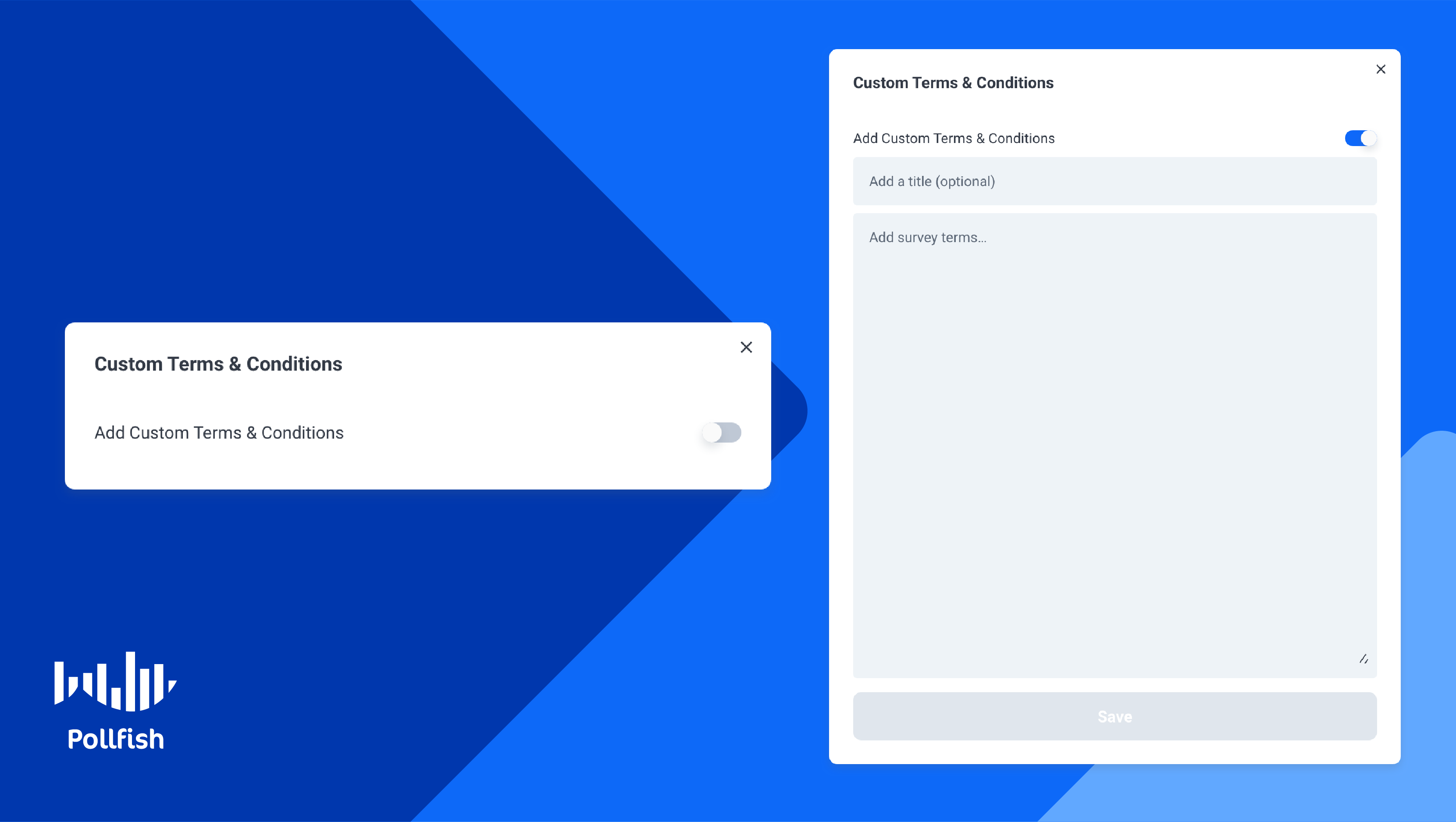
The new Pollfish feature allows researchers to customize their surveys to the max. Researchers can now include additional custom terms and conditions in their surveys.
These serve as a preface to the survey, allowing respondents to understand the unique conditions and aspects of the survey itself and its broader study. As such, it is a kind of opener to the survey that allows respondents to understand what their participation entails.
Additionally, they are always used in surveys and are mandatory for respondents to accept in order to take a survey.
The Pollfish online survey platform makes it easy to create, edit, insert and access customer terms and conditions to all kinds of surveys. Researchers don’t need to be tech-savvy to include these, making their creation and use a seamless process.
Thus, democratizing the survey pre and post-launch is an easy cycle for all those involved.
This article explains the necessity of using custom terms and conditions in surveys, along with how to include these elements on the Pollfish platform.
The Need to Preface Surveys
Adding custom terms and conditions in surveys is a necessity for many brands and researchers, as it prefaces key aspects of the survey and its study. More importantly, it relays key information about matters such as privacy, data use, consent and many others.
This is important, as it enables the survey and its larger study and campaign to be as transparent as possible. By including these terms and conditions, respondents won’t be left guessing the implications of their participation, how their data will be used, whether they’re answering anonymously and more.
In this way, adding terms and conditions can assuage respondents’ fears, dispel their misconceptions and eliminate any misgivings they may have about taking the survey. Thus, it gives respondents peace of mind, increasing their likelihood of taking the survey, rather than opting out.
Although indirectly, this contributes to shorter total survey completion time, as more online users will opt into the survey, accelerating competition times across surveys.
In addition, some countries require compliance with data anonymity laws, such as the GDPR. Therefore, the data subjects residing in such countries will require surveys that have terms and conditions alluding to GDPR compliance.
Finally, given that these terms and conditions can soothe respondents' doubts about taking the survey, this feature can help raise the survey completion rate. This plays a major role in extracting speedy insights.
Additionally, if a brand decides to use its name and likeness in a survey, using terms and conditions will help it improve its standing and reputation. While this may seem to be a stretch, consider the importance of these terms/conditions. The fact that they remove respondents’ doubts, fears and misgivings will paint the survey and its study in a positive light.
When a business is associated with such a survey, its brand will therefore be seen in a positive light.
What Terms and Conditions Include and Can Be Used With
As the above section explains, including terms and conditions in surveys is important for a number of reasons — from legality, to giving respondents peace of mind and everything in between.
As such, survey terms and conditions can be used for a number of purposes and applications. The following lists what these terms and conditions can include and the applications they can be used with:
- Disclaimers
- Respondent responsibilities
- Acknowledgment and acceptance
- User privacy
- Terms of use
- Modification of prior services or terms
- Confidentiality
- Registrations
- Proprietary rights
- Anti-spam reassurance
- Advertisers
- General transparency
How to Include Custom Survey Terms and Conditions in a Survey
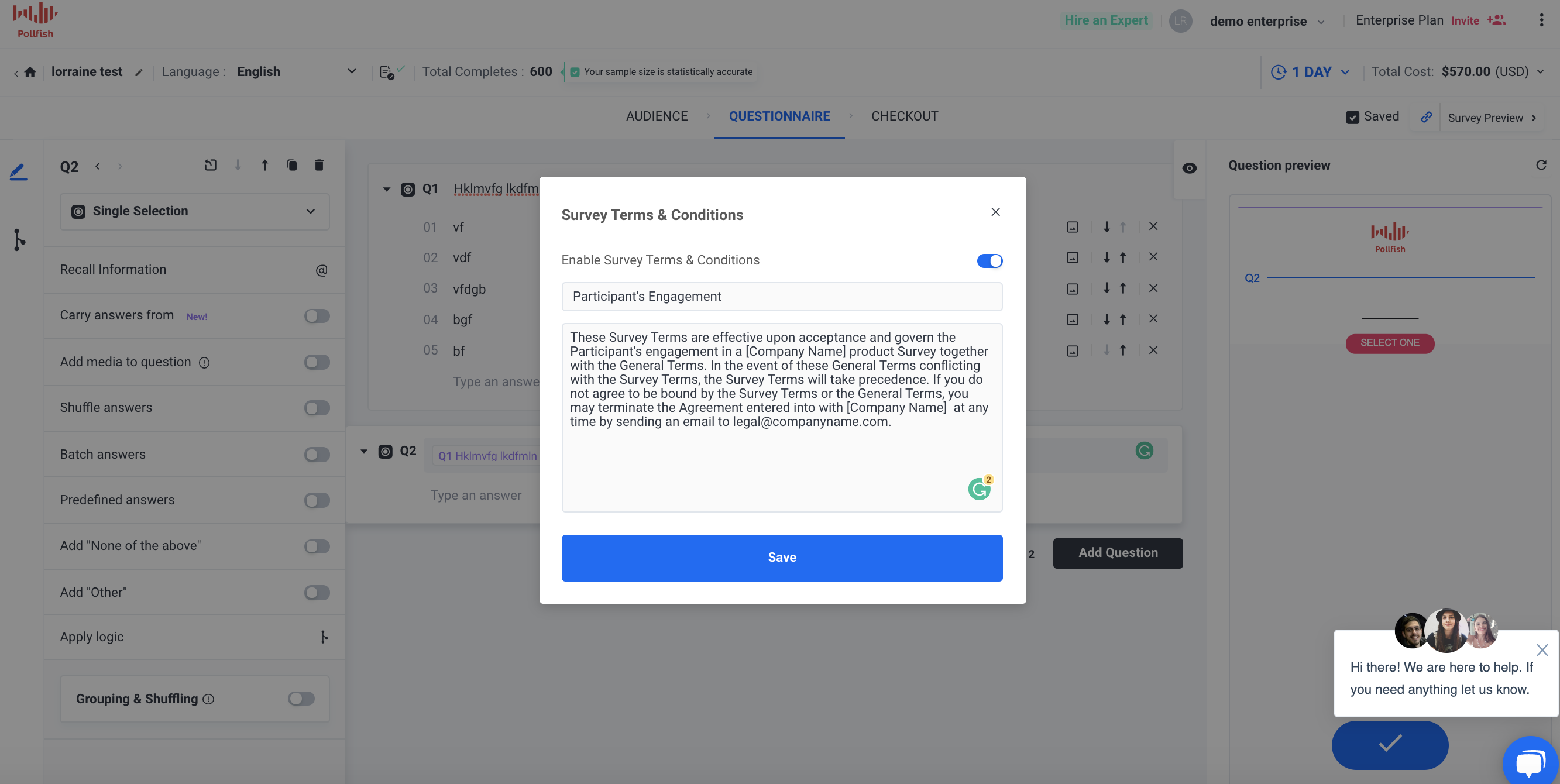
The Pollfish platform makes it practical and easy to include additional survey terms and conditions to any kind of survey and for any region of the globe.
The following explains how to create custom terms and conditions for survey research and how to use them with any kind of survey.
Follow this short step by step guide:
- Open up a survey in the Pollfish dashboard.
- To access the Survey Terms & Conditions button in the navigation, you must be in the targeting or questionnaire section.
- In the upper navigation bar, click on the icon of the survey with a small check on its bottom right.
- This represents the button to click on for creating, editing and accessing survey terms and conditions.
- A pop-up window will appear, titled Survey Terms & Conditions.
- In the pop-up, click on the toggle to enable the terms and conditions.
- In the field below, you can add and edit the text of the terms and conditions.
- Hit Save to save your changes.
- You’ll see the Survey Terms & Conditions icon on the top navigation will have a green checkmark and blue dot to mark that survey terms and conditions were added.
- To view the terms and conditions in the survey click on the Survey Preview button at the top right
- Click on the text of the terms and conditions button on the bottom; this will expand the text.
- Right next to the Terms and conditions a link “View Survey Terms” will appear
- This will take you to the additional terms and conditions specifically.
A Holistic Survey Experience
This new feature allows market researchers to provide a holistic survey experience to their target population, as terms and conditions are critical elements of a survey’s introduction, as well as its entirety and its study at large.
Its ease of access and editing makes including these terms easy, practical and stress-free. Researchers will never have to worry about respondent misgivings, fears and other roadblocks when it comes to prefacing their surveys about privacy, agreements and many other issues.
This new feature is therefore the perfect solution for creating and accessing survey terms and conditions — the kind that are unique to each company, campaign and customer.
How Pollfish Provided Global Support for an App Client
How Pollfish Provided Global Support for an App Client
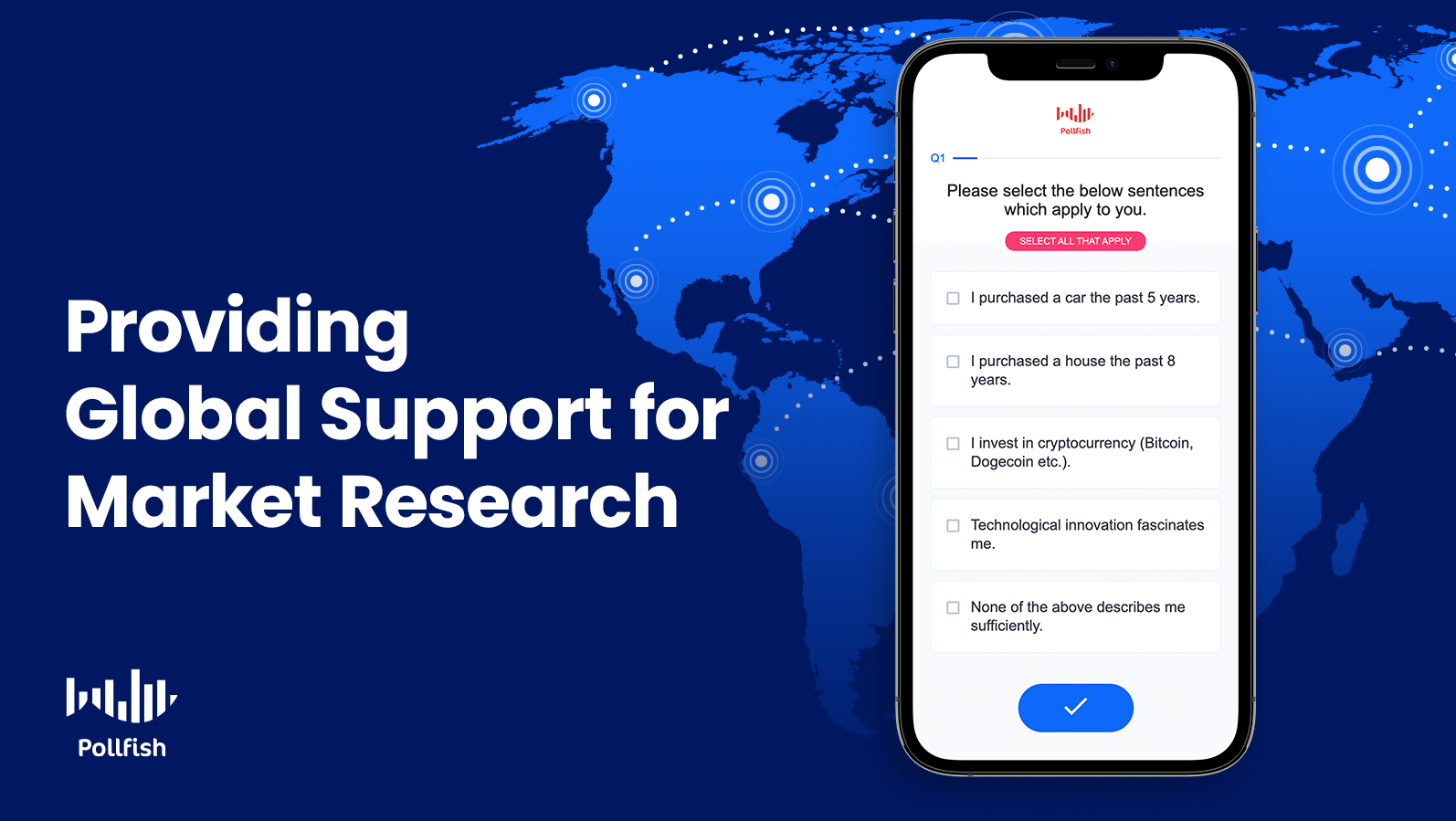
Market research is crucial for brands that have a global footprint, as well as those seeking to venture into the international stage. Pollfish empowers businesses with global support for all of their global market research needs.
This kind of research is a must for tapping into the minds of a global target market, along with building customer loyalty across the world. 95% of global customers consider customer service as essential in their business choice and loyalty.
It is virtually impossible to create a strong customer service and experience for global customers without understanding their habits, opinions and needs. Thus, conducting market research is essential.
While there are plenty of syndicated research firms and market research platforms available, they do not all deliver robust global support for international market research.
This article lays out how Pollfish is the ideal platform for conducting market research across nations, along with a use case from an app client that shows the prowess of Pollfish global support.
Global Support Capabilities for Market Research
A potent market research campaign should involve using a tool that makes it easy to access global markets and one that can operate at speed. Ideally, it should take the same amount of time to run a global market research campaign, as it would a domestic one.
Survey research is a practical form of conducting global market research, but not every survey platform is built the same. As such, not all platforms provide the same kind of quality for conducting surveys locally, let alone abroad.
Pollfish provides a unique edge to businesses who seek to branch out into the global arena, as well as to companies that have an established global presence. There are several ways that the Pollfish online survey platform provides market researchers with top-notch global support, the kind that enables them to quickly gain customer insights from a multitude of countries.
First off, Pollfish offers customer support on a 24-hour basis, so researchers in practically all parts of the globe can get support at any time of the day. Thus, they’ll never have to change their busy schedules to accommodate their market research tool. Instead, the platform is accommodated to their liking and needs. Any misgiving, doubt or difficulty they may experience is no problem for our team of market research experts working round the clock to ensure an effective global survey study.
Next, the Pollfish platform does not charge businesses extra for running surveys outside of their home countries. As such, market researchers can freely conduct global market research, reaching any country they wish, without incurring additional charges. They have access to a wide net of global customers, all under one platform and without being monetarily constrained.
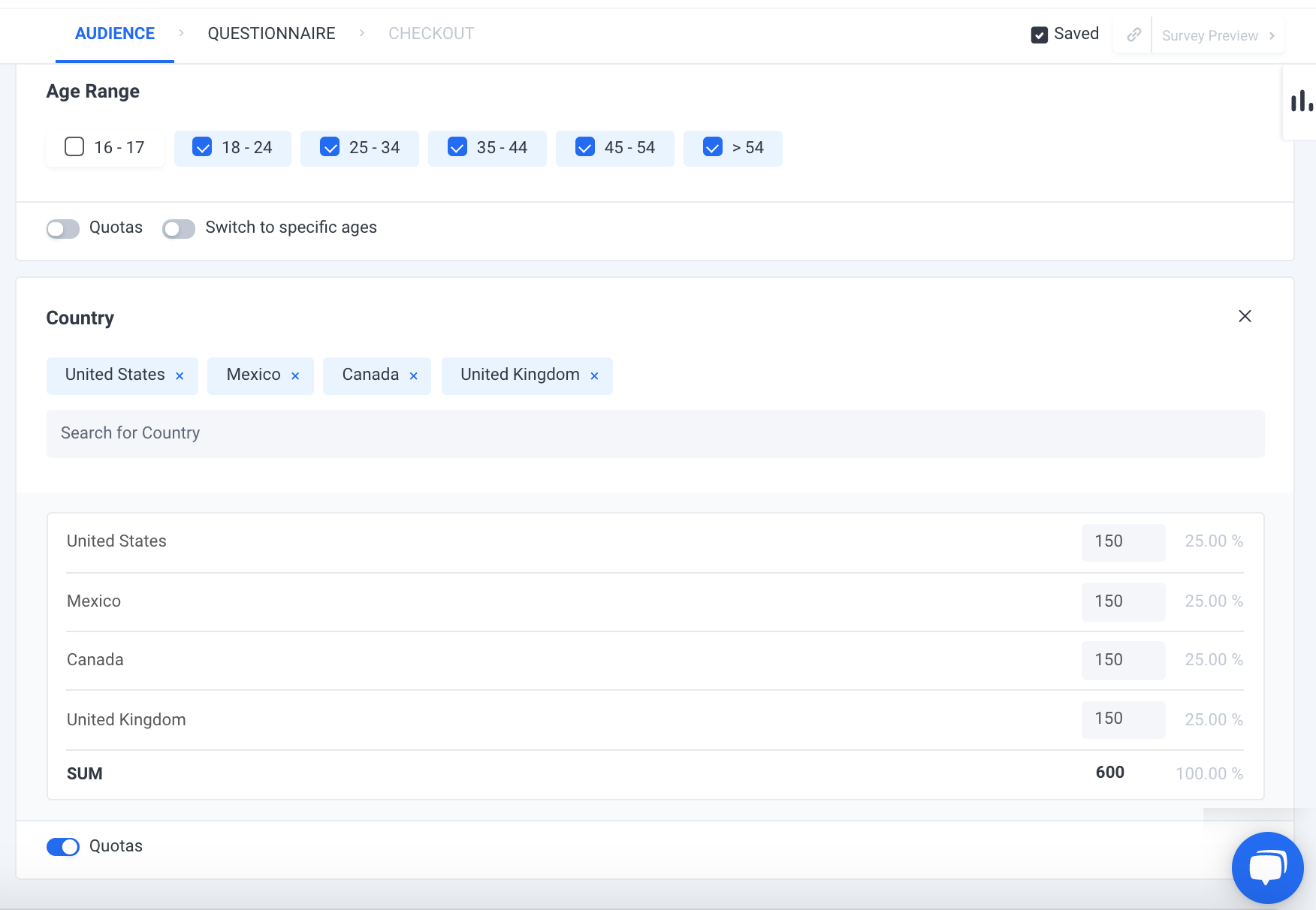
Finally, the Pollfish market research platform itself is equipped with various features that allow researchers to carry out their global research needs smoothly and quickly. This is largely because the platform is powered by some of the most advanced forms of technology, some of which eliminate the need to use other primary research tools and conduct secondary research.
The Prowess of the Pollfish Online Survey Platform for Global Research
In reference to the previous section, aside from the 24-hour support and no additional charges for global surveys, the Pollfish online survey platform offers many high-quality features for conducting global market research.
The following lists all the capabilities that Pollfish offers to ensure a strong and seamless global survey research campaign:
- Survey deployment to 160 countries
- Translations feature
- Multiple audiences feature
- Allows researchers to filter audiences by country, in order to see results on a per-country basis for comparisons.
- Survey deployment and iteration is executed at speed
- Researchers can survey up to 10,000 respondents per survey
- Reaching customers internationally does not require a longer survey completion time.
- It takes the same amount of time to deploy, illiterate and retrieve global responses.
- Targeting virtually all demographic groups
Use Case with Pollfish App Client
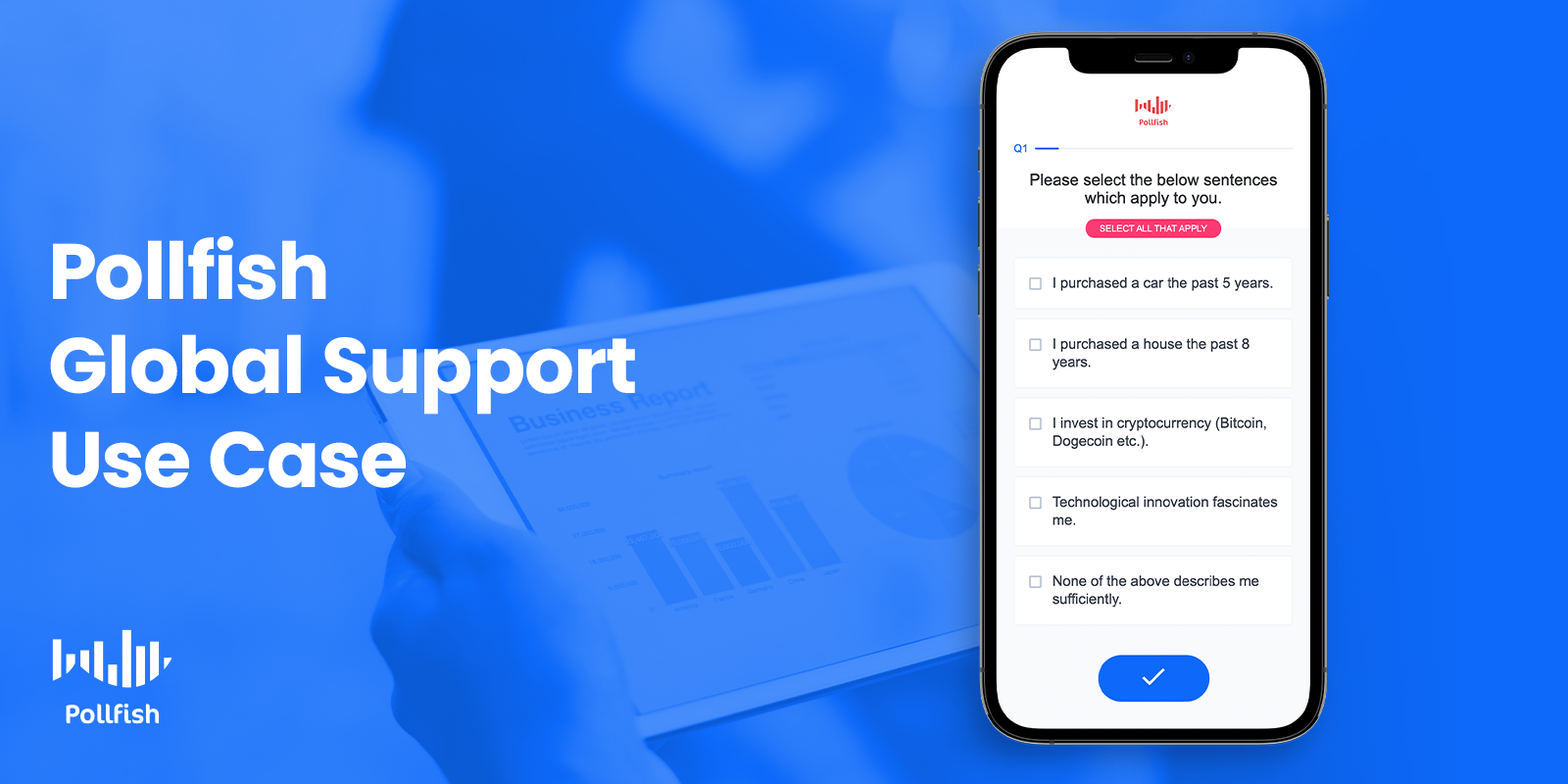
A Pollfish client used the Pollfish survey platform for a global expansion campaign. Lingokids, a learning app for young children, sought to expand the presence of its app in order to achieve international brand awareness.
Lingokids faced several challenges in its pursuit. First off, it still needed to crack the challenge of developing local brand awareness, making that of the global variety a much more difficult feat.
The app client also set out to generate stories for press releases that speak to its target market.
With traditional market research models, the client would have endured limitations and high costs. But with Pollfish, Lingokids received access to a reasonably-priced self-service platform market research that operates on RDE (random device engagement sampling).
RDE is a kind of sampling that engages users in their natural digital habitats, without pre-recruiting them. Rather, their participation is completely voluntary and anonymous. Thus, the respondents are not pressured to answer questions in any particular way, which stamps out certain survey biases and fraud.
The platform uses artificial intelligence and machine learning to perform ongoing quality checks as the surveys are running. This way, all of the resulting customer data that researchers receive is of the highest quality. These checks filter respondents through various kinds of quality criteria and disqualify participants who do not meet these standards.
For example, surveys with gibberish answers and flatlining answers (same multiple-choice answers consecutively) are disqualified, along with respondents that mask their geographical location or use a VPN. This method discards poor data, removing biases, errors and useless information — without the researchers having to lift a finger.
Based in Spain, Lingokids started launching Pollfish surveys in 2019 Sain to generate data and stories for press releases. But Lingokids’ success is not limited to Spain. The app client surveyed customers in other geos, such as the US, Mexico, and other countries.
“I’ve seen amazing results. If I put together all the press releases based on Pollfish data, not only in Spain, but in the US, Mexico, and other countries, I would say we’ve gotten over a hundred stories in tier 1, 2, and 3 media. That’s pretty good for a start-up,” said Sara Mateos-Aparicio, Communications Manager at Lingokids.
As a Spanish company, understanding the US market has posed several challenges. But
survey data from Pollfish paid off, as Lingokids used their survey data for different media campaigns in California and New York. The survey data helped them measure impacts pre-and post-campaign.
Those surveys were completed in about three to four days, with Lingokids also having received 800 survey responses in 24 hours.
Lingokids was able to not only measure and grow its brand awareness, but understand how to grow globally by analyzing the media types that work best to reach its target market in different countries.
Survey data also helped Lingokids learn about its competition along with gathering subtle insights into the culture of the US market. For example, Lingokids learned that children’s safety with learning apps concerned US parents more than parents in many other countries. This granted Lingokids the insights it needed to better launch US campaigns, having centered them on safety.
In summary, by running international surveys on the Pollfish online survey platform, Lingokids obtained over 100 stories in tier 1, 2, and 3 media, measured brand awareness in pre-and post-media campaigns, netted 800 survey responses in 24 hours, unearthed data on the competition in other countries and gained actionable insights into other cultures.
“You can make assumptions about your market, but they’re just assumptions,” said Sara Mateos-Aparicio, Communications Manager at Lingokids. “With Pollfish, you can confirm those
assumptions and they become data.”
Global Support with a Strong Online Survey Tool
While plenty of online market research platforms offer a best-in-class solution, not all such platforms offer global support and capabilities as does the Pollfish platform. Businesses who are serious about studying their target market in other countries must use a robust online survey platform.
Businesses should therefore invest in a platform that allows them to study their global customers at scale and at speed, without worrying about incurring higher costs or running into technical issues.
A self-service survey platform, Pollfish gives businesses quick access to various global markets and offers 24-hour support, should researchers encounter any difficulties or concerns. It helps hundreds of clients run global market research on a daily basis.
If you would like to learn more about how Lingokids leveraged the Pollfish platform, read our use case.
How to Build a Strong Survey Campaign for Market Research
How to Build a Strong Survey Campaign for Market Research
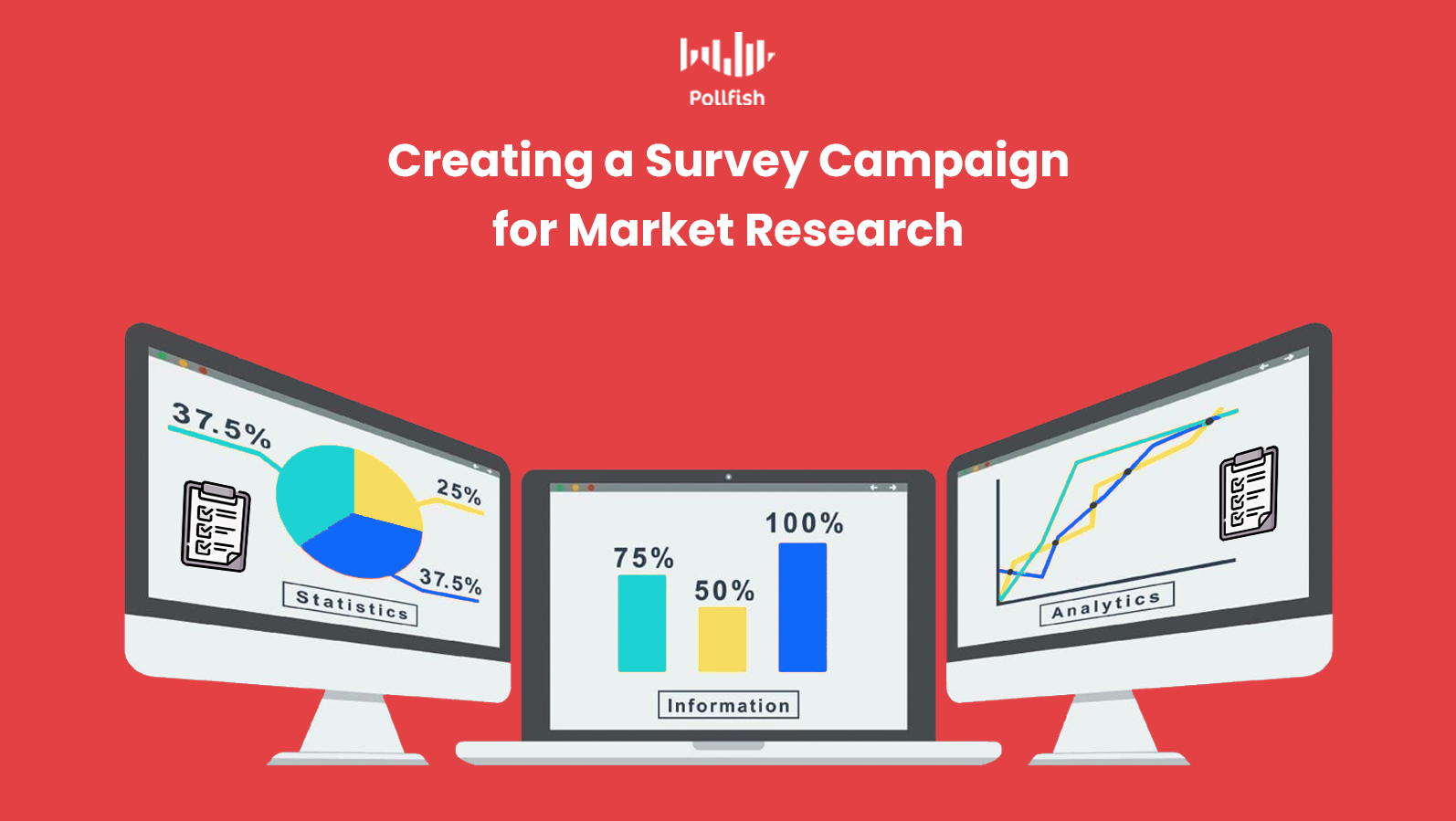 A strong survey campaign is invaluable for market research. This is because survey studies provide the most potent means of gathering your own unique research — primary research, that is.
A strong survey campaign is invaluable for market research. This is because survey studies provide the most potent means of gathering your own unique research — primary research, that is.
A survey campaign is part of a far larger endeavor, as it is just one methodology in a research campaign. Thus, it requires more than merely being planned out; researchers must decide on one of the types of research to conduct before settling on a survey.
There’s also more when it comes to producing a strong survey campaign. This article explains this in full detail, so that businesses and market researchers can create surveys that reap the most insights.
Defining a Survey Campaign
A survey campaign is a series of efforts used to gain firsthand data from a target market in market research, or a target population in general research.
This kind of campaign is a primary research method in which researchers attempt to find a solution to a problem. For example, it can focus on the problem they would come upon in descriptive research.
But there’s much more to survey campaigns. Although they can be used to resolve problems discovered in a type of research, such as exploratory, causal, etc., they can be used for a wealth of other purposes.
When it comes to business, a survey campaign can determine if a new strategy will be beneficial, detrimental or affect little to no changes. What even more important is that such a campaign allows businesses to understand the lifeblood of their business: their customers.
What a Survey Campaign Helps Reveal for Your Business
Dovetailing off of the previous section, there are many things a survey campaign can help a business achieve. Some of these go beyond market research itself.

Here are some of the other purposes a survey campaign helps serve:
- Understanding the makeup of your target market
- Via the target market survey
- Market segmentation for further segmenting
- Testing a creative strategy for a number of macro applications such as
- Advertising
- Branding
- PR
- General marketing
- Obtaining customer feedback and getting a deep read of your target market
- Via a customer satisfaction survey
- Includes the NPS, CSAT, CES, visual rating survey & more
- Discovering the CLV (customer lifetime value)
- Via a customer satisfaction survey
- Excelling in product endeavors
- Testing product satisfaction
- Innovating products with new features and upgrades
- Understanding how your product compares with competitors’
- Avoiding negative publicity
- Regular checks on the opinions of your brand
- Finding customer aversions to avoid in your messaging and brand’s image
- Obtaining employee feedback
- Running a pulse survey
- Via the employee satisfaction survey
- Improving your CX
- Via a customer experience survey
- Using a survey for content marketing strategy
- Driving Lead generation
- Includes B2B endeavors
- Helps you learn more about the specific needs and desires of your target market, or B2B clients such as partners, vendors and other businesses.
- Acclimating with your niche
- Allows brands to keep up with market and niche trends
- Makes it easier to change with the times
- Completing a market analysis
- Being able to compare your brand with others
- Getting a feel of the thoughts and attitudes in your overall space
Proving the Value of a Survey Campaign
While many brands turn to market research, they do not always carry it out successfully. With primary research specifically, it is more difficult to reap accurate, bias-free insights, as it involves far more than just an analysis, but the labor of conducting the research yourself.
Additionally, a business may encounter the issue of biases, a lack of participants and even responses that are hard to draw conclusions from.
A survey campaign provides the antidote to all of these problems — when conducted correctly, that is.
A survey campaign is useful for reasons beyond the 10 in the aforementioned list. Here are a few ways this kind of campaign is a must for businesses:
Since surveys help measure the CX (customer experience), they inform businesses on a variety of touchpoints that influence their CX and how they do so. This is important, as 86% of buyers are willing to pay more for a good CX. Thus, a business can improve its customer experience, which will therefore increase sales.
76% of customers expect businesses to understand their needs. A properly designed survey campaign will do exactly this. This is because you can create a number of different, although related surveys under one campaign. By creating diverse surveys, you can study a more diverse set of segments in your target market. This kind of research will help you understand and adapt to their needs.
When it comes to branding and customer loyalty, businesses can stand to run a survey campaign for a variety of reasons. First off, 86% of consumers believe that authenticity is important when they decide on the brands they choose to support.
Surveys can also help in brand recognition; simply deciding on a correct signature color can spur brand recognition as high as 80%. Creating a survey campaign with visually-oriented surveys can achieve this.
Then comes the sensitive issue of news and culture, particularly social and political issues. 64% of consumers from across the globe said that they would either boycott or buy from a company simply for its political or social stance. A survey campaign allows you to quiz your target market on its thoughts surrounding current affairs so that you take the correct position or none at all.
How to Build a Survey Campaign
The following explains how to set up a survey campaign, ensuring you use the correct surveys, frequency and other functions within your campaign.
- Find what it is you need to study; consider the things that matter to your business and have little to no research, such as what you would use in exploratory and explanatory studies.
- Or, if you have already conducted exploratory or explanatory research, consider other related factors or issues that you’d like to study.
- Once you find a topic of study, which can be any business phenomenon, for example, a decrease in sales of a particular product, tie it to a larger purpose or campaign.
- For example, perhaps it fits into branding more, or perhaps it is an advertising issue.
- When you’ve affixed your campaign with a macro-application (ex: advertising), decide whether you’ll need to run one or several surveys.
- Consider conducting causal research on the matter, as this will find cause and effect relationships and since survey launches are one of the last steps of the entire research process.
- If you perform this research and discover cause and effect relationships, you may need to rework your intentions or original questions.
- Come up with several questions. An ideal starting point is to sift through the 6 main types of survey questions and to deliberate which will be of most use.
- Using the question types as question templates, form your questions.
- When you’ve come up with 10-15 questions, consider cutting them and organizing them into two or more surveys. (Shorter surveys have greater response rates).
- As you organize your questions, create the appropriate theme for each survey.
- Create a callout that briefly explains what the survey is for.
- Customers are fond of transparency.
- Here you can mention that the survey is to improve their own CX, or that their opinion matters.
- Use a strong online survey tool to create, launch and run your survey to the correct target market.
- Perform a survey data analysis and jot down key findings.

- Use your findings to draw a conclusion about a hypothesis, or continue doing further research, such as correlational, causal or even experimental.
- Your original results will bring key findings that answer your work’s key questions, answer a hypothesis or prompt further research.
- This may require further survey research.
Consolidating Your Research
A research project often manifests as a long and winding process, rife with several sub-campaigns and tasks. A survey campaign can help tame this process, easing the way to finding key results.
This is because surveys provide agility and speed to insight — when conducted correctly. It is virtually impossible to find hundreds or even thousands of respondents that properly fit your target population, let alone convince them to take a survey.
That’s where an online survey tool offers a multitude of value, as it can carry out these tasks and more, with little to no effort from you. A strong online survey tool is thus a necessity for your survey campaign needs.
Diving Into the Pulse Survey to Meet Business Demands
Diving Into the Pulse Survey to Meet Business Demands
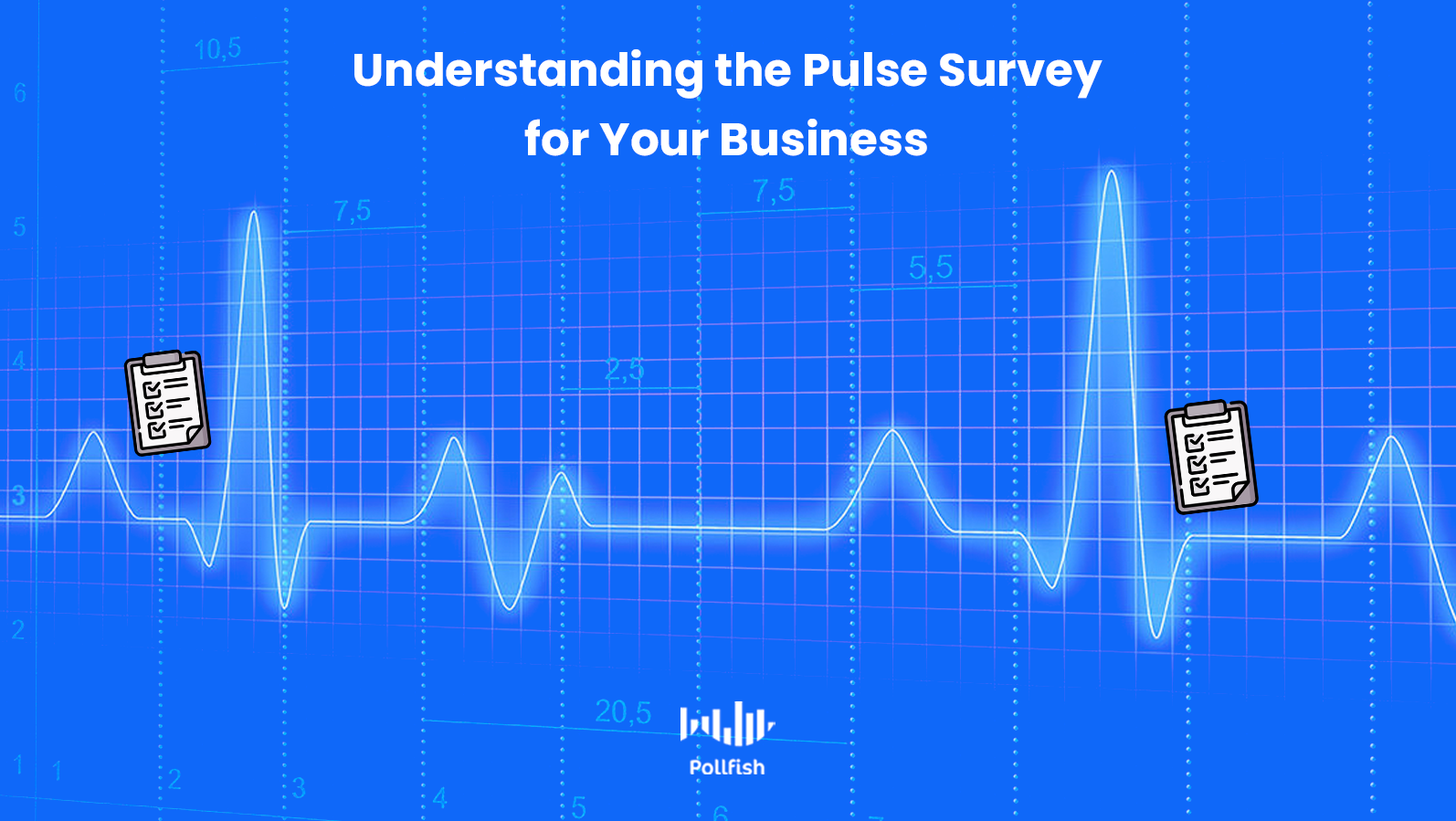
Running a pulse survey is key to properly running a business — and running a business is not always a smooth operation. There is a wide breadth of considerations to carefully examine, yet even with continual check-ups, they are still susceptible to going awry.
When you measure the pulse of your business, the premise that the pulse survey hinges on, you are able to keep track of your business and how others engage with it — be they your customers, your partners and your employees.
This article delineates the pulse survey in-depth, so that you can build effective survey studies for your market research needs and be in tune with the pulse of your business.
Defining the Pulse Survey
The pulse survey gauges the pulse of your business, as its moniker indicates. “Pulse” refers to the “motions” the key individuals to your company go through in regards to your business. As such, this survey type must be administered frequently.
Like a biological pulse, the rhythmical throbbing of that which keeps you alive, i.e., blood — a business’s pulse involves understanding the lifeblood of its business. This includes customers’ opinions, employee engagement and sentiment and the thoughts of your vendors and partners. The latter is especially true for a B2B business.
As such, when those in the business world discuss “keeping a pulse” on their company, they are alluding to collecting the feedback surrounding this pulse.
Pulse surveys often refer to employee pulse surveys, which are a kind of employee feedback survey, however, they can collect the pulse from a variety of respondents and serve various purposes. These include:
- Evaluating customer satisfaction
- Measuring employee satisfaction
- Finding the opinions, needs and sentiments of partners, business clients and vendors via B2B surveys
- Understanding your content consumers via content marketing strategy
- Getting insights into the operations of your business
The Key Characteristics of a Pulse Survey
What specifically makes up a pulse survey?
Pulse surveys contain more specifics than merely the key trait of gathering feedback to understand the inner workings of your company. Instead, they include key aspects you need to adhere to when deliberating how you’ll use this survey type and how to create one.
- Marked by frequent check-ins on the same audience.
- This can be weekly, monthly, bi-annually, quarterly or set in a custom frequency.
- They measure the impacts of small and large occurrences.
- The surveys tend to be 3-6 questions in length.
- The surveys are concentrated on either a campaign, topic, experience, etc.
- They’re used to track trends and hyper-segment your respondents (employees, customers, etc.) similar to market segmentation.
- These surveys are used to study changes among opinions, behaviors, attitudes and more within a particular group.
- They can be used to compare shifts in opinions among certain segments with consistency in that of others.
The Importance of Using a Pulse Survey
Incorporating a pulse survey is key to ensuring various successes for your business. There are a number of ways in which the pulse survey benefits your business.
First off, it doesn’t merely tell, but it proves to your respondents that you value their insights. While not many people enjoy taking surveys, a short survey that explains in the intro or call-out that it is being conducted to improve the service/experience for customers lets them know that you pay attention to their needs.
This is beneficial when it comes to vendors and partners, as it gives them the reassurance that they are not merely contractually bound with your business, but that their input matters and that they have a say in the business relationship.
The same notion applies to employees, the group chiefly used in pulse surveys. Workplace stress is common; in fact 40% of workers reported that their work was extremely stressful. Thus, a pulse survey is necessary to curb workplace stress. It is also crucial to keep employees engaged and satisfied with their work.
After all, a happy workplace won’t incite them to leave the job, whereas a toxic one inevitably will.
As such, relying on a pulse survey grants you the insights you need to keep issues at bay and cater to the needs of your business.
The Advantages and Disadvantages of a Pulse Survey
A pulse survey offers several advantages to a business. If the prior section on the importance of using a pulse survey wasn’t reason enough to start regularly implementing it, the following enumerates even more benefits that this survey provides. Like any business tool, however, there are some downsides to a pulse survey as well, as the following includes.
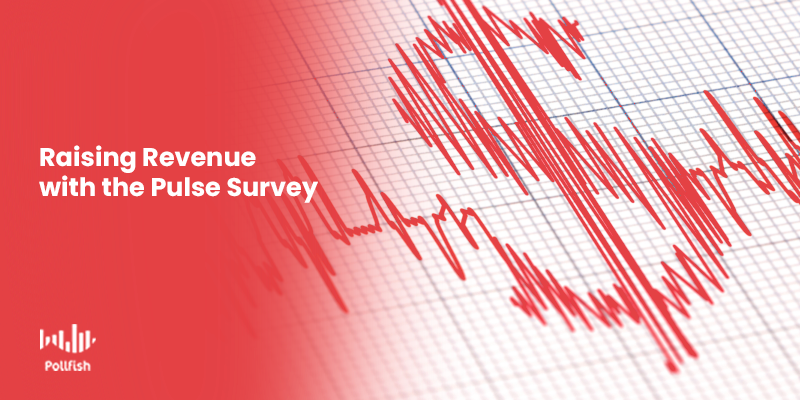
A pulse survey campaign can help raise revenue by improving customer/partner relationships.
The Advantages
- It is deployed periodically, giving you continuous key insights and updates on your target sampling pool.
- It identifies current (thus extremely relevant) insights on a wide array of issues and occurrences.
- The insights allow you to make much-needed upgrades, corrections and changes on a regular basis.
- Because it is employed periodically, you can identify trends and the ways in which your target sampling pool changes.
- It helps you understand the impact of events, whether they are large or minor.
- It shows you whether new employee policies, updated products or new vendor terms have had positive or negative effects.
- It is useful for assessing reactions to recent (or even ongoing) changes.
- It allows you to monitor virtually any activity or sentiment.
- These surveys tend to be short and thus are easy to create.
- Checking on the pulse allows you to zero in on current needs and objectives with a targeted set of questions.
The Disadvantages
- Requiring constant updates and feedback can be off-putting for customers, employees, vendors and all else.
- When no major event, change or attitude springs from the previous round of pulse surveys, it can be difficult to create new pulse survey targets without coming off as repetitive.
- These are not as anonymous or random as other business surveys, as such, some respondents will be reluctant to take them or refuse entirely.
- Less anonymity incurs less honest answers, giving way to survey bias.
How to Conduct a Pulse Survey
Creating a pulse survey requires taking several key measures to ensure you carry it out properly and gain the key data that captures your pulse. Here is how to create a pulse survey for your various needs.
- Start from scratch by defining the purpose of your pulse survey campaign.
- First, lay out the high-level considerations, such as who the targets of the survey are and which area of business you would like to survey.
- Then, find something specific and current that you need to check up on.
- Decide on the most apt length of your survey.
- This should be an approximation since you haven’t created your questions yet.
- Create a welcoming call-out and/or intro to your survey so that the respondents will be more inclined to take it.
- Include call-outs such as: “Your feedback means so much to us” and “Help us help serve you.”
- For employee pulse: “Let’s make work a better place,” and “Complete this survey so we can improve your work and responsibilities.”
- Create your questionnaire, consisting of 3-6 questions and no more than 10 for longer surveys.
- Make sure the questions are relevant to the topic/issue you are checking in about.
- Consider your answers; some may prompt follow-up questions while others won’t be relevant to all respondents based on their answers. Thus, apply advanced skip logic.
- Determine a suitable survey cadence.
- Taking the following into consideration: how often the aspects you’re surveying are subject to change.
- How soon you’re going to make changes and if those changes warrant immediate pulse surveys.
- Put together a list of positive and negative responses in your survey analysis.
- Ideate how to address the negative attitudes, i.e., how to allay them and what to change in your business.
- Use advanced people analytics to your pulse data for market segmentation purposes, as well as a deeper read of the pulse.
- Share the results.
- Review the results with the appropriate team. Ex: partnerships, marketing, HR, the product team, etc.
- If you run an employee pulse survey, share the findings with the entire team for the sake of transparency.
- Take action.
- After reviewing the results, take any necessary action to improve employee, customer and partner relations and satisfaction.
- Make necessary changes to the campaign itself, such as to the cadence, etc.
Pulse Survey Question Tips and Examples
Create questions that are broad (at least the early ones) so that they are pertinent to all the targeted respondents. The idea is to avoid survey bias along with question skipping.
Make sure to include at least one open-ended and one closed-ended question. This is especially useful if a multiple-choice question warrants an explanation, one that cannot always be answered via a follow-up multiple-choice question, but rather one with an open field.
This gives their original responses much more depth and a qualitative component to the survey.
Make sure your questions are specific and use skip logic if need be. Your questions should yield measurable data that creates actionable insights.
Here are a few pulse question examples:
Pulse Survey Question Examples
- Do you feel that the company has done a good job of informing employees about [initiative]? [Yes or no]
- If no, use skip logic to route them to an open-question for an explanation.
- Target audience: Employees
- On a scale of 1-7, how strongly do you agree with the following?: We have effectively managed the recent change in our organization.
- Uses a Likert scale
- Target audience: Employees
- What do you think of our new product feature?
- Use nominal answers (varied and not scaled)
- Target audience: Customers
- How can we better make your holiday shopping experience?
- Use nominal answers (varied and not scaled)
- Target audience: Customers
- How comfortable are you in supplying us [various goods, needs, etc]?
- Use a Likert scale and skip logic to an open-question for an explanation of a low rating.
- Target audience: Vendors and partners
- What are some of the changes you would like to see to ensure a mutually beneficial partnership?
- Use an open-ended question.
- Target audience: Vendors and partners
Continually Improving Your Business
Regardless if you are a B2C or B2B company, in order to sustain a successful business, you need to monitor the pulse of various issues in your business. Whether it is ensuring a lengthy partnership — one with renewal, achieving a higher CLV (customer lifetime value) among customers or maintaining employee satisfaction, you need to implement a pulse survey campaign.
Such a campaign will enable you to keep a constant check-in on the aspects of your business that matter the most, along with those in need of alterations the most. Either way, deploying a periodic pulse survey to various targets will help you understand the key players of your business.
This will allow you to serve them better and forge business relationships with longevity.
A successful pulse survey relies on a robust online survey platform. This tool should be able to facilitate a vast amount of survey types and styles and deploy them to the correct audience with ease and little to no effort from the researcher.
If you have such a tool in hand, you are setting up your business for various successes.
Conducting Global Market Research with a Dynamic Market Research Platform
Conducting Global Market Research with a Dynamic Market Research Platform
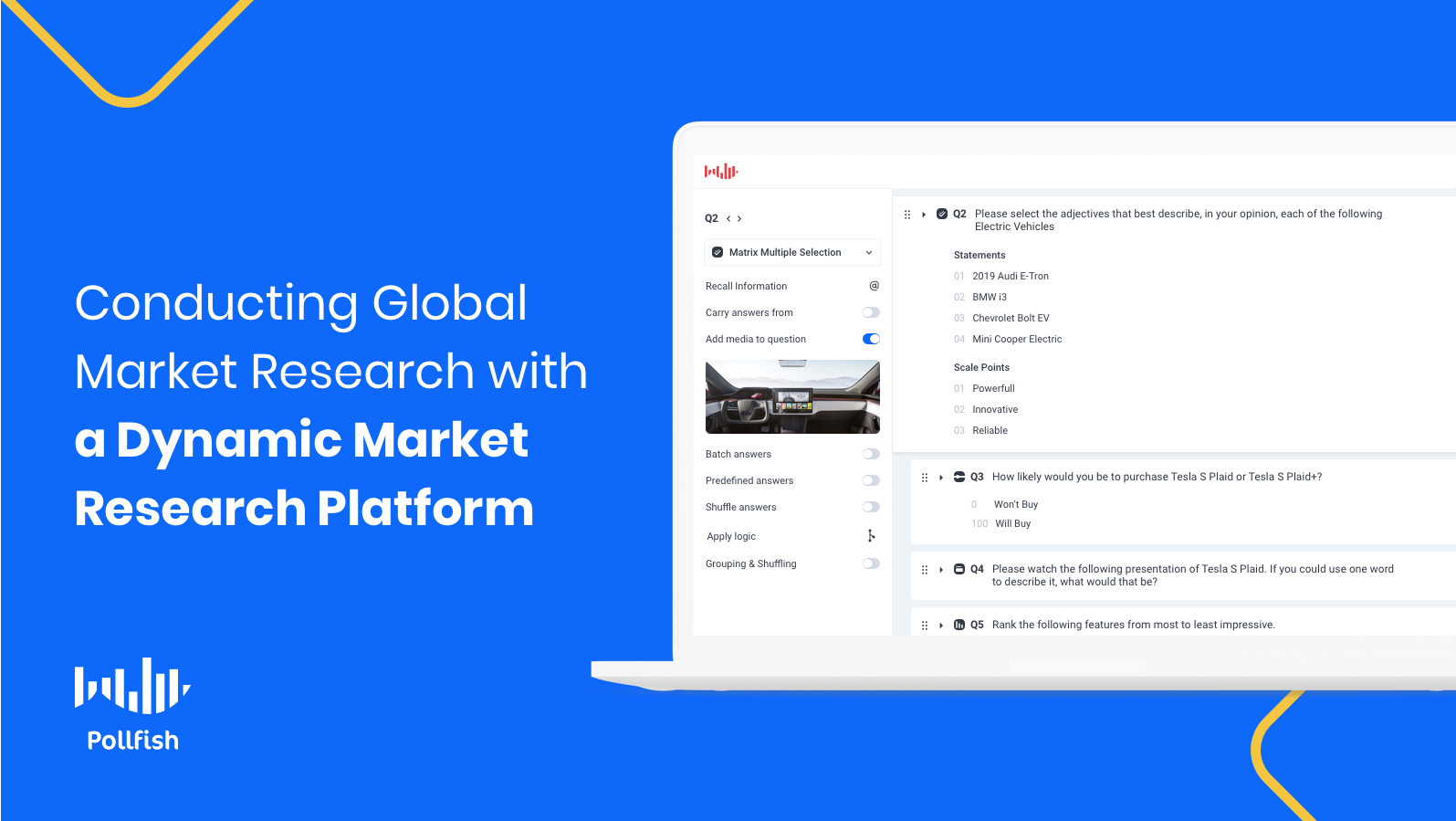
Businesses that seek to offer products and services to international customers would be remiss not to conduct global market research. This form of research prepares both current businesses participating in a global market, along with prospective ones.
Understanding customers from across the world is equally highly regarded internationally, as it is in the US. 66% of global customers expect companies to understand their unique needs and expectations. As such, providing the correct experiences and fulfilling the needs of customers is no longer a secondary requirement for global consumers.
Performing market research should therefore not be limited to domestic studies, whether it is for an international e-commerce business or a content provider who seeks global research.
This article expounds on global market research, its importance, key components, challenges and how to conduct it, along with a use case from a real Pollfish client.
Understanding Global Market Research
Global market research stems from the same idea as traditional market research — the process of gathering information about target markets and customers in a specific industry.
Global market research refers to the organized effort of systematically collecting, recording, designing, analyzing and interpreting information pertinent to a target market on a global scale. As such, this kind of market research studies individuals outside of local and national markets, examining those in the international space instead.
There are various market research techniques that market researchers can apply to their global market research campaigns. Existing and emerging technologies facilitate these efforts, breaking down what would have been obstacles.
Global market research is not the complete equivalent of traditional or domestic market research. While these two forms of research are parallel in certain regards, they differ in their approach and focus on different core subject matters.
Market research on a global scale is applicable to all business concepts, from the viability of new products to studying and increasing customer lifetime value (CLV). Therefore, conducting market research across the globe can help businesses improve in various ways and meet a wide variety of KPIs and objectives.
The Importance of Global Market Research
This kind of research is invaluable on various fronts — for businesses and general research purposes alike.
Firstly, the constant advancement of technology has opened many international business opportunities for companies to expand their business by venturing abroad. This is especially the case for SaaS companies and businesses that provide services that don’t require shipping materials to foreign countries. Thus, it is far more efficient to offer global services.
This means that businesses have target markets that far exceed those within their home country. To compete with any business in any industry, businesses must satisfy their customers and these concepts lay the foundation of the importance of global market research, because, to please customers, businesses must understand them at granular levels.
Market research provides a means of doing so, with various sources and methods to extract data on global customers.
Secondly, marketing strategies do not pan out in the same way across localities and different segments of a target market. As such, they will certainly not be received in the same way across different countries and continents.
Due to different cultural norms, languages and connotations, a company’s messaging, communications and marketing campaigns will therefore not have the same effect as they intend in different geographical markets. Global market research helps reconcile these differences across countries, by specifically focusing on cultural and geographical differences.
Additionally, information that contains the exact responses from a business’s global customers arms it with the knowledge and insights necessary for various business operations. It provides valuable information on executing changes or launches to product development, design, delivery, packaging and quality.
It also allows marketers to establish unique advertising campaigns, ones that are either made solely for a particular international market, or those that tweak existing campaigns to fit the cultural norms and sensitivities of other countries.
Moreover, conducting this research helps businesses properly set their prices when selling to customers abroad. This way, their pricing is reasonable across countries. For example, a piece of furniture may retail for a completely different price in the US than it would in France.
Furthermore, the global digital population is on the rise, with 4.66 billion active worldwide internet users. This figure represents 59.5% of the global population. A vast majority of these users, 92%, access the internet via mobile devices.
It would be negligent for businesses not to study this colossal population to improve all of their marketing and general business goals. They would simply need to use the correct online market research platform to examine this inflating population.
The Components of Global Market Research
Global market research has its own set of key components, some of which largely distinguish it from traditional and domestic market research. These components allow researchers to focus their survey research exclusively on the behaviors, sentiments, opinions and needs of customers abroad.
By paying attention to these components, businesses can gain insights that improve any globally-targeted marketing campaign and even forge brand loyalty.
The following lists several major components of global market research:
- The focus on a specific geography: Market research allows businesses to zero in on a specific country or continent.
- Reaching customers that appear to be unreachable: This involves using market research techniques to reach international customers directly, that is, through primary research tools, such as a focus group or an online survey platform.
- Not all market research methods and tools offer the same global reach.
- An analysis of cultural differences: This covers examining all possible cultural differences, from the role of women versus men in shopping, to religious holidays, to business closings, etc.
- Essentially, this allows brands to adjust their marketing and create messaging that can better relate to customers in different countries.
- An analysis of economic differences: This is critical to understand when setting up a global pricing strategy. This is because all countries have different economic climates; some may be undergoing a recession, some may incur strong unemployment rates, while others may be experiencing an economic boom — at least in a particular market.
- Tapping Into global markets via their native language: Not all members of a global target market speak English, which means that to study them, researchers will need to reach them in their native language.
- Ethnic considerations and national customs: Similar to cultural differences, studying specific national and ethnic concerns is important, as it helps businesses avoid marketing campaigns that can offend global customers’ sensibilities.
- Understanding typical Incomes: The income considered low or middle-class in one country may not be so in another. Global market research helps brands understand how typical incomes are classified across global regions.
- Additionally, it reveals common salaries and other income information across the demographic groups of a country.
- Product demand: Some countries will have demand for things that barely get an afterthought in other countries. This can be for a specific product or a product feature enhancement.
- By conducting global market research, businesses can understand the exact needs of their global target market and innovate accordingly.
- This way, they can create more viable products for international sale and satisfy their customers abroad.
The Challenges of Global Market Research
Global market research is beset with its own share of challenges that make it difficult to conduct, let alone complete. However, there are survey tools that make conducting this form of research practical and easy. But first, businesses need to acclimate themselves with the challenges that may come their way should they conduct global market research.
While some techniques and methods used in domestic market research may also be applied to their global counterparts, customer preferences are not easy to determine. As such, it is difficult to compare global markets due to the greater diversity in cultural, social, and economic differences, all of which affect consumption.
Then there is the challenge of conducting the research in the first place. Global market research is a far more ambitious project, therefore, it tends to require more hours on conducting various techniques, such as scouting for secondary research. These will differ among companies and research campaigns.
As far as methodology goes, global research also requires more time spent on execution. Researchers would need to contend with extracting the data, designing the study either across one country abroad or multiple countries, coordinating between different countries and piecing together the resulting data.

These are just some of the points of friction that businesses must grapple with before conducting their global studies.
Market researchers must also be somewhat knowledgeable of the local customs and environments of their respective targeted countries to carry out the research successfully, especially when conducting primary research. This will help researchers avoid making their subjects feel uncomfortable, therefore cutting back on survey attrition. This will also help researchers structure their primary research.
Then, there is the monetary challenge: large survey research projects are costly endeavors, some of which may incur hundreds of thousands a year. This is especially challenging for businesses that have just broken into the international market.
How to Conduct Global Market Research
Conducting global market research requires many of the prerequisites of domestic market research. A business will have to compile secondary and primary resources to perform an exhaustive study.
There are various secondary sources that businesses can incorporate into their global research.
Government agencies provide free access to statistics on their residents, a kind of hard data that is valuable for preliminary studies. These statistics are useful for learning about a foreign country’s demographics, state of its economy, and commerce status.
The International Trade Administration churns out economic reports, forecasts and infographics on various countries and industries. Their website can complement domestic market research, as it contains statistics on US national trade.
Researchers can also attend international trade shows, workshops, and seminars in their industry — some offer this virtually. For example, The Tradeshow Network Marketing Group lists all the major international tradeshows and their respective industries.
Each industry also has dedicated online publications that publish articles on emerging trends and news on the industry, including customer preferences, technology, products and services and other related information.
Finally, businesses need to conduct their global market research; this can be done in several ways. They can turn to survey panels, mail-in surveys, phone calls with existing customers and field research.
Online surveys are the most potent tools for global market research.
This is because an online survey platform, such as Pollfish, offers the best distribution method and allows businesses to study any segments of global customers, as it reaches 160 countries.
Using random device engagement (RDE), Pollfish targets digital users in their natural environments. Thus, respondent participation is randomized and voluntary, removing the risk of survey bias, as respondents are not pre-recruited and completely anonymous. Pollfish has the power to deploy surveys to a vast network of global customers, as it distributes surveys across the most visited websites and apps, to a sampling pool of 250 million people.
Additionally, Pollfish allows survey creation for 46 languages and also offers a Translate Survey feature. This way, businesses can seamlessly reach non-English speaking customers across the world.
Researchers can meet all of their quotas with the Pollfish online survey platform, with the option of adding quotas in the screener, along with multiple audiences per survey. This way, they can target various segments of their global target market. The platform also offers a survey completion time, so that researchers have a reasonable estimate of the time it takes to draw all the preset survey responses.
Global Market Research Use Case with a Pollfish Client
Kalsec, a food manufacturer that produces space and herb extracts, colors and food protection for the food and beverage industry, has used the Pollfish platform to run a global market research campaign.
Thus, the company deployed surveys in various global markets: those in the North American, European and Asian regions, specifically in Canada, the UK, France, China and Thailand. Given that to understand the needs of global customers, businesses must conduct studies on various global regions on a country-to-country basis.
This is exactly what Kalsec did, arming the business with critical insights they would need to pay extra for, had they used another online survey provider.
Specifically, Kalsec studied consumer behavior and purchase decision-making to get a sense of its global customers' purchasing behavior about its brand. The surveys that Kalsec ran centered on the snacking behaviors of residents in the five aforementioned countries.
The company sought insight on what drives customers from making their snack purchases and their Pollfish-powered global market research allowed them to compare customer behavior across various countries and better tailor their shopping campaigns.
Essentially, Pollfish technology broke down geographic and communication barriers across these global markets, granting speedy insights that the company wouldn’t obtain from secondary research alone.
Making Continuous Improvements in the Global Arena
Businesses that seek to offer their services to global customers ought to make use of global market research. The same goes for businesses with an established global presence, given that understanding customers is at the core of maintaining business success.
To conduct global market research, businesses need to use a robust online survey platform, such as Pollfish. A strong online survey tool will enable businesses to set granular demographic requirements for global customers, ask a wide style of questions (multiple-selection, single selection, ratings, etc), add advanced skip logic, add media files and use multiple audiences per survey.
Pollfish is built for global market research, as it offers 24-hour support, so that regardless of which time zone a client is in, they can easily reach the customer support team should they require assistance. Pollfish users do not have to pay more to gain access to global customers and send global surveys, a major advantage over the many other platforms.
A DIY survey platform, Pollfish allows businesses to make global market research an attainable goal.
The Complete Guide to Market Research Techniques
The Complete Guide to Market Research Techniques
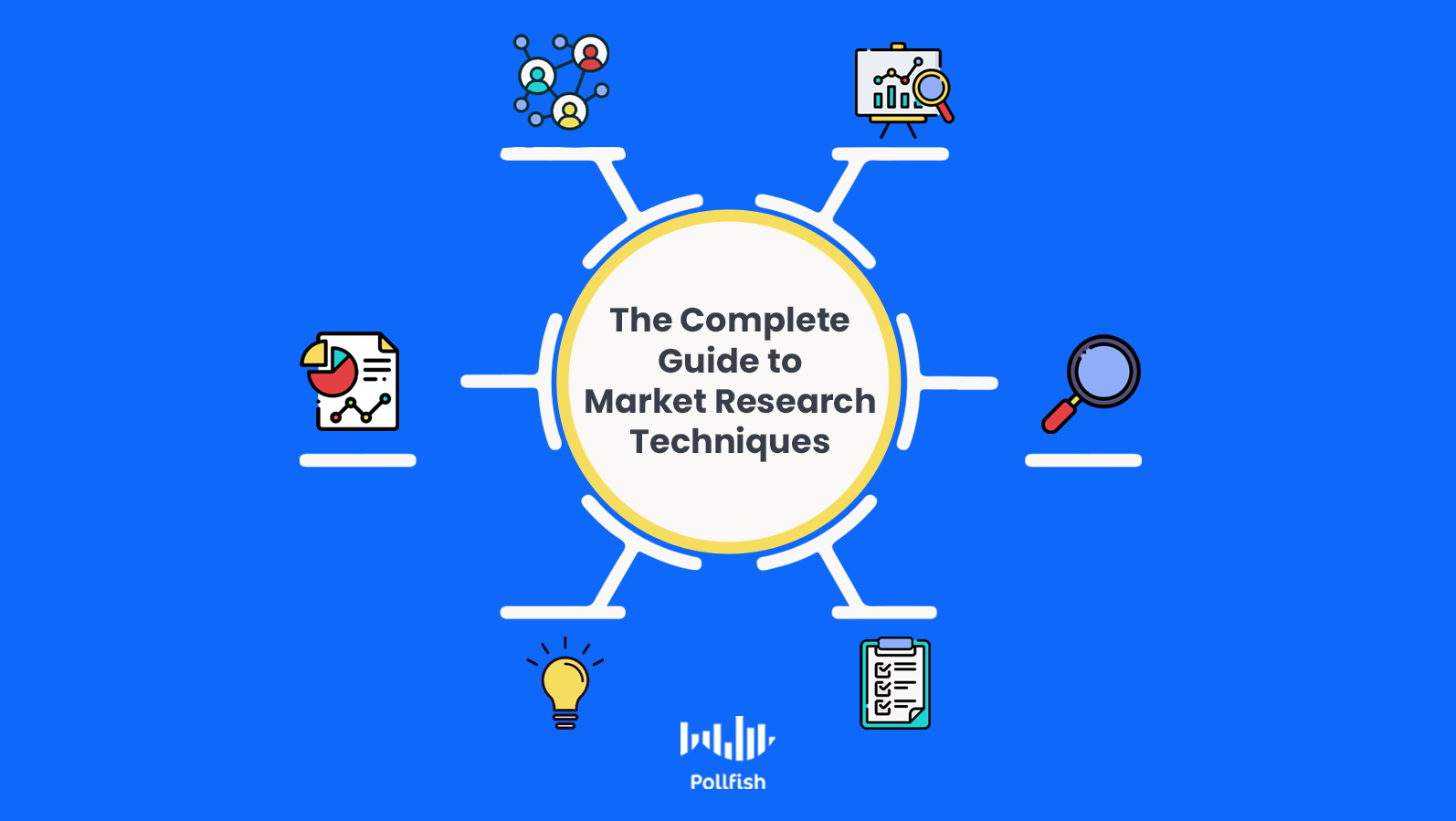
If you intend to conduct market research, you'll need to be well versed in market research techniques. These methods will help you carry out a sufficient market research campaign, allowing you to better serve your customers and steer your business toward.
But when you are facing a concept as broad as market research, it is rather challenging to know where to begin and how to conduct the various forms of research.
This complete guide to market research techniques will help lessen this challenge so that you can stride confidently into all your research needs.
Defining Market Research
Like several aspects of business, market research is not bound by one concept; rather it is an umbrella term that encompasses a wide array of practices.
Market research is the process of gathering information about your target market (the people most willing and likely to buy from a business), segmenting your buyer personas (market segmentation) and amassing knowledge on your competitors.
This category of research allows businesses to gain insights into the quantifiable aspects of their industry, along with the opinions and attitudes of past, current, potential and churned customers.
The ultimate end goal of market research is to learn how successful your product or service is and/or will be within your industry, niche and most importantly, within your target market.
Primary Vs Secondary Research Research
The chief divider of market research involves the method of researcher participation, aka, the way the research is conducted.
Primary research denotes an active form of research, in that researchers conduct the research themselves. This signifies that the information they are seeking has not yet been collected, or, that the research they need has been gathered, but they seek to gain their own, firsthand data.
As such, primary research involves using primary data, that is, the data that a researcher would extract themselves.
On the contrary, secondary research entails research that has already been conducted and (usually) has been made available. With this research category, the researchers aren’t required to amass their own intelligence; rather it involves aggregating knowledge that has already been collected and passed on by others.
As such, this kind of research largely involves summarizing, synthesizing and scrutinizing data and other forms of intelligence. Secondary research often involves studying the primary research that others have already conducted and packaged in their chosen form.
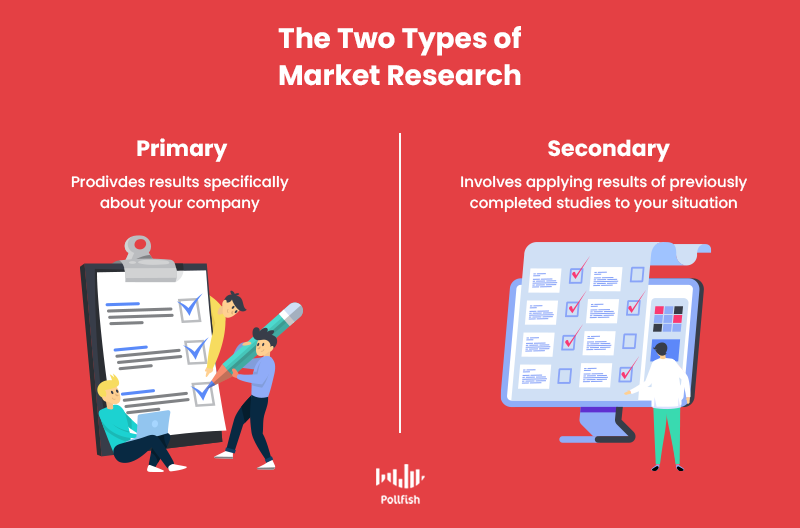
It is important to incorporate both styles of research for a comprehensive market research campaign. This is because there are going to be subjects that you cannot study simply through one form of research. For example, your competitors aren’t going to publish the primary studies that depict them in a negative light, no matter how accurate they are.
Another example is your own set of customers; secondary research alone is not going to provide an adequate amount of data on them. There may not even be any data on your particular customer segment.
Primary Market Research Techniques
Here are a few techniques for completing primary market research. Researchers need not attempt all of these techniques, as some will be more useful and easier to execute than others. It all depends on your preferences and goals.
- Interviews: One of the more intimate methods, interviews can be managed over the phone or in person.
- Focus Groups: A more interactive form of interviews, this technique gathers data from a group of about 6-10 participants. Focus groups study subject matter experts. Using a moderator, these groups aim to incite discussion among the participants. This is a good method to perform to learn about a specific segment of your target market. Focus groups rely on open-ended, broad and qualitative research questions.
- Field Research: This is an observational method on subjects in their natural environment. To use this method, researchers do not interfere with the outcome or behavior of a situation. This technique grants direct observation of people and their interactions. Ex: An electronics brand seeks to observe how customers interact with a new line of products. They may do field research on in-store customers to study this.
- Surveys: Online surveys are the best distribution method and allow you to study any topic. A strong online survey tool will enable you to set granular demographics requirements, ask a wide style of questions (multiple-selection, single selection, ratings, etc), add advanced skip logic, add media files and use multiple audiences per survey. Surveys can take many forms; business and consumer surveys alone form macro surveys that include their own survey types.
- Test Marketing: This technique involves testing the usage and opinions of a new product by selling it to a small segment of one’s target market. For example, software brands test-market by using the “beta” versions of new features/products on a small group of likely customers. This method helps predict how a new product will fare in a larger market.
Secondary Market Research Techniques
Secondary market research techniques require using sources specific to your industry and niche. While some sources may be general, you’ll need to gather intelligence most pertinent to your target market — or at least your industry. Here are a few citations to use for secondary research.
- Government Resources: The government collates massive data on citizens; this data is free and can be found on a number of government websites.
- The Census Bureau: Provides a portrait of the American economy, market sizes, populations, demographics and more. It includes the American FactFinder tool, which finds demographic, economic, social, household, and other data on geographic regions.
- The U.S. Small Business Administration: Captures statistics on economic matters such as employment, salary, income, sales and more. The SizeUp tool allows businesses to compare themselves against competitors.
- The U.S Department of Commerce: With offices scattered across the US, the U.S. Department of Commerce generates data on industries and their products and services.
- The Bureau of Economic Analysis, which is a part of this department, creates economic reports on income, expenditures, and even savings data on a quarterly basis. This site shows the trends in product/service demand based on spending.
- Enterprise Sources: These resources are not free, but offer invaluable insight into particular trades and subsectors.
- Trade Associations: Perfect for studying your industry, they’re made up of groups of businesses that cater to specific subsectors. Use the following to find your industry association.
- Research Associations: Composed of research analysts, these associations to be independent, although some are affiliated with trade associations. These organizations provide businesses with granular reports on specific subsectors of an industry. They include:
- Forrester: Research in the consumer business and tech sectors.
- Statista: Statistics, reports, infographics & more on 170 industries and 150+ countries.
- Gartner: Research for senior leaders with business insights, advice and tools.
- IBISWorld: Industry reports by sector and country.
- Mintel: Market intelligence across industries and countries.
- Dun & Bradstreet: Data, analytics, and commercial insights for businesses with 120 million business records on over 1,000 industries.
- Industry Blogs and Content-Oriented Websites: Each industry has online publications dedicated to reporting on them. These are useful for the latest updates, trends and breaking news, the kind that a major report or downloadable asset may not provide. Here are a few examples across different industries.
- Ars Technica: A website covering news and commentary on the technology, science and politics space.
- The Business of Fashion: News and intelligence on the fashion industry.
- Grocery Drive: News that focuses on the grocery and ecommerce spaces.
- Premium Beauty News: Markets, trends, laws, new products and other news within the cosmetics industry worldwide.
- Realtor Magazine: News surrounding the real estate industry.
- Educational Institutions: Colleges and universities have research departments that study a wide range of business data. These insights are not free but involve heavy-duty market research from faculty and students. They include:
- Graduate student projects
- Faculty-based projects
- SEO and SEM Reporting: SEO is critical to growing your business online, as your target market won’t purchase from your business if they don’t find it. SEO/SEM sites help you gather keyword research to learn the most relevant to your niche.
- SEMrush: For SEO, PPC, content, social media and competitive research.
- Moz: For rankings, keywords and link testing.
- ahrefs: For rankings, site audits and keywords.
- Google Keyword Planner: For finding keywords, tied with Google Ads.
- Screaming Frog: A site crawler for technical SEO site audits.
Quantitative Research vs Qualitative Research
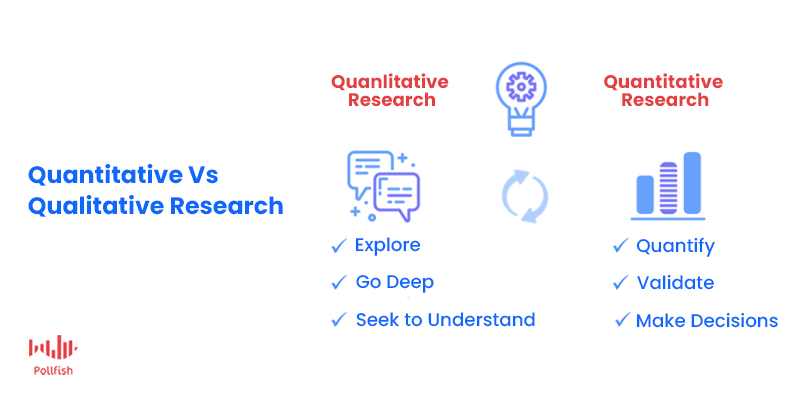 Another crucial market research division is that of quantitative and qualitative research. Unlike primary and secondary research, which can exist without one another, quantitative and qualitative research are used in complementation.
Another crucial market research division is that of quantitative and qualitative research. Unlike primary and secondary research, which can exist without one another, quantitative and qualitative research are used in complementation.
This means you would often use both in your research campaigns.
Quantitative research is marked by measurable data that quantifies the opinions, attitudes and experiences that respondents report. It collects numerical data for producing statistics, finding prevalence and identifying patterns.
The goal of quantitative research is to test a theory or hypothesis. Another common objective is to measure opinions in regards to a particular research topic. Quantitative research is also used to find causal relationships between variables, predict outcomes and create generalizations on broad populations.
Computing an instance or phenomenon takes precedence in this form of research, rather than gathering the reasons and motivations behind it. This kind of research works out the “who” and “what,” of a research subject.
Qualitative research stands in contrast with quantitative research, as a descriptive form of research. This form of research inquires into the depths of an attitude, opinion or phenomenon. Instead of delving into the statistical aspects around a research subject, which is known as the “what,” it works to find the reasoning behind it.
As such, this research doesn’t seek to describe a situation, opinion or occurrence; rather it focuses on establishing the “why” behind it.
Qualitative research was designed to take place in natural environments, i.e., places in which research participants can provide thorough answers. This environment can take place on or offline.
This form of research relies on using psychological, ethnographic and sociological approaches to study a target market. The design of a qualitative study evolves (along with the participants it studies).
In this form of research, there is no such thing as a single reality; rather it is changeable and subjective. It is highly interpretive, as it doesn't involve simply adding or crunching numbers.
Quantitative Market Research Techniques
Quantitative research involves using methods that collate measurable data that can be encapsulated in graphs, charts, tables and other visualizations. Here are a few techniques for gathering this kind of data:
- Experiments: Researchers can conduct experiments on products, such as producing beta versions, as tech companies do. They can also do A/B testing on digital experiences such as digital ads, emails and even on-site experiences. Additionally, researchers can run experiments in-store to test customer satisfaction with employee service and product layouts.

- Observations: Part of field research (as mentioned under primary research), researchers can observe customer behavior and occurrences in natural environments such as in-store behaviors. Observations can also exist online, for example, by using session replay tools found in analytics software.
- Statistics and other Published Resources: Researchers can garner quantitative data by studying secondary research. The technique involves looking at statistics websites, along with other data sources such as infographics and reports. This is a good starting point when dealing with quantitative data; it can also be used to compare findings between past and present data.
- Surveys: Perfect for discovering the “what” with multiple choice and multiple selection questions. Matrix questions help find the intensity of a phenomenon. There are swaths of different survey types you can implement, including macro ones like business surveys and consumer surveys, along with specific surveys such as the Net Promoter Score (NPS) survey or the Employee Satisfaction Survey.
Qualitative Market Research Techniques
Quantitative research techniques necessitate being able to understand opinions in more depth to uncover motivations, reasonings and consumers’ general psyche. These methods do not require quantifying any findings. Instead, they require using exploratory and open-ended questions; the kind that fully reveal the bedrock of consumers’ attitudes.
Here are a few techniques:
- Focus groups: These spur natural discussions by incorporating a small group of people with a moderator who prompts various conversations. Focus groups consist of people who share demographic attributes to study a target market or a segment of it. Unlike interviews, which are one-on-one, focus groups allow multiple people to speak, mimicking natural discourse and therefore having the participants influence each other.
- Unstructured interviews: Unstructured interviews are in-depth interviews in which there are no premeditated questions. Instead, the interviewer asks open-ended questions that relate to the research topic. This way, the conversation runs like a natural exchange. The interviewer would keep questions relevant to both the research topic and the participant’s experiences.
- Textual and visual analyses: A form of secondary research, researchers can draw analyses from qualitative research documents already available. This including looking at trade publications or research publications that focus on various consumers and other demographics.
- Case Studies: This technique uses thorough investigations on a participant, a group, an event or a community. It merges various sources such as interviews, observations and surveys. Researchers analyze the data from these sources and put together the case study document. This is used in clinical medicine, but can be applied to numerous other industries, including the general business vertical. This method uses both information from the past (retrospective) along with present and everyday manners.
- Surveys: Surveys can be every bit as qualitative as they are quantitative. In a qualitative survey, you would use open-ended questions. These often dovetail to quantitative questions by going more in-depth on them. Thus, you would need to use skip logic, so that if a respondent replies in one way, they would get rerouted to the appropriate follow-up question. Like with quantitative surveys, qualitative surveys can be applied to macro concepts like in cross-sectional surveys or for more specific ones, such as with community feedback surveys.
Other Forms of Market Research Techniques
Aside from the above two major types of market research classifications, there are several other major kinds of research techniques. Here are a few vital examples:
Retrospective Research
This research studies past events to see if or how they contributed to a current topic of interest. Also called historical research, this study inspects historical data. It falls under cohort studies, which follow a group of participants bound by a similar trait. This research uses observational studies that determine how often a phenomenon occurs within a targeted population. Techniques include:
- Survey panels
- Longitudinal surveys
- Interviews
Cross-Sectional Research
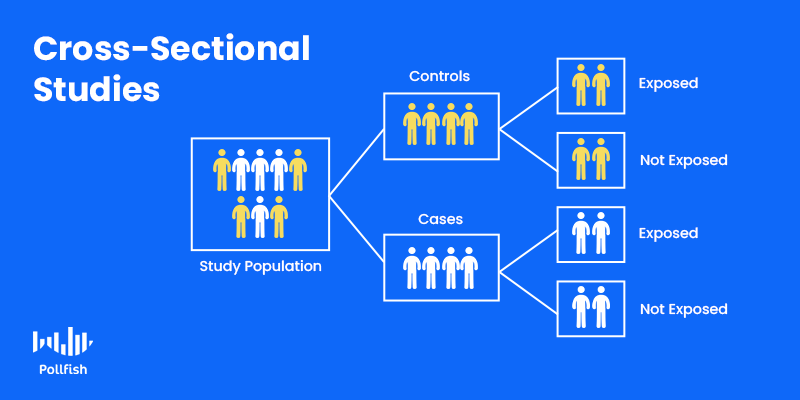
A cross-sectional study collects research on a particular population at one fixed point in time, essentially serving as a snapshot (aka cross-section) of a studied population. This type of survey does not require using a survey panel as this method follows a panel over several points in time. It is contrary to longitudinal studies, since they study participants at ongoing frequencies. Instead, it seeks to gain an overall portrait of a phenomenon during its time of study. Techniques include:
- Field research (especially recent studies)
- Interviews
- Surveys (Ex: community feedback surveys)
Prospective Research
Prospective research aims to predict the likelihood of a future event or issue. It is focused on outcomes and can also determine relationships between variables. A prospective study usually involves investigating a cohort of subjects over a long period. This research tends to be experimental in nature, as it seeks to uncover relationships between variables. Techniques include:
- Experiments
- Trials
- Longitudinal Surveys
- Focus groups
- Survey panels
Wading the Waters of Market Research
While this guide covers the most pertinent and useful forms of market research technique, there are still more to explore. That is because certain techniques, such as survey research methods have many forms and subsets of methods that brands can apply to their campaigns. A strong research campaign will guide you deeper into the many techniques available, some are tried and true, while others are newer.
When you fortify your secondary research with a strong primary research tool, your campaign will be on the right track towards unique insights for all your business and market research needs.
How to Conduct Descriptive Research to Advance Your Business
How to Conduct Descriptive Research to Advance Your Business

Descriptive research is one of the main types of survey research and makes up the majority of online surveys.
Many times, researchers need to conduct descriptive research before they attempt to problem solve, as this sort of research aims to set the scene of a problem. Moreover, it is used prior to an issue being fully realized by researchers, as it is used to probe into the background of a problem.
Because of this, descriptive research is often used as a preliminary research method. However, this is not always the case, as when researchers are fully aware of an issue, they can perform experimental research or correlational research, which can be conducted first.
But in most cases, to fully understand a situation, descriptive research is useful in that it paints a clear picture of the problem, so it is often conducted in the early stages of research, just after exploratory research.
This article offers a deep dive into descriptive research, how it’s conducted and how it can help advance your business.
Defining Descriptive Research
As its name suggests, this form of research seeks to describe the key factors of a problem, phenomenon, situation or the behaviors of a population.
Descriptive research expounds on a population, occurrence or situation that a researcher chooses to or requires to study. As such, it aims on discovering latent details about a particular situation to fully understand it.
A preliminary research method, descriptive research forms the what, how, when and where surrounding a subject of study rather than on the why.
Before conducting research that explains why a phenomenon exists, it is critical to understand that it exists in the first place. It is also important to understand its full context, including particulars you may not have known about before conducting descriptive research.
Descriptive research is conclusive in nature, as the data derived from this research can be used to create statistics and make educated inferences on a target population.
The Key Aspects of Descriptive Research
Now that we have established the core meaning of descriptive research, it is critical to understand its makeup. This form of research has various qualities researchers ought to look into, to better understand its characteristics.
The following enumerates the key features of this research:
- Provides basic details regarding a research problem.
- Performed after exploratory research: it delves deeper into a hypothesis or theoretical idea established in exploratory research, while still being an early part of the overall research process.
- Fills in missing data: this is especially true when exploratory research is first performed.
- Preplanned and structured: Designed for further research around a phenomenon.
- Quantitative in nature: this research gathers numerical data used for making statistical analyses and drawing conclusions in relation to the studied population.
- Incorporates qualitative research: it can also include elements of qualitative research, to describe the research problem thoroughly. This is because descriptive research is more explanatory than exploratory or experimental.
- Uses uncontrolled variables: variables in this research are not controlled, as the researcher’s job is simply to observe and report, but not to interfere with the variables.
- Creates statistical relevance: this method studies a population to draw statistical inferences about it.
- Gateway for deeper research: After the results of descriptive research are collected, they can be used to power further analysis and research methods.
- Cannot make predictions or find causal relationships: it covers the what, how, etc. aspects that can be later used for further research such as experimental, causal and prospective research.
Why Your Business Needs Descriptive Research
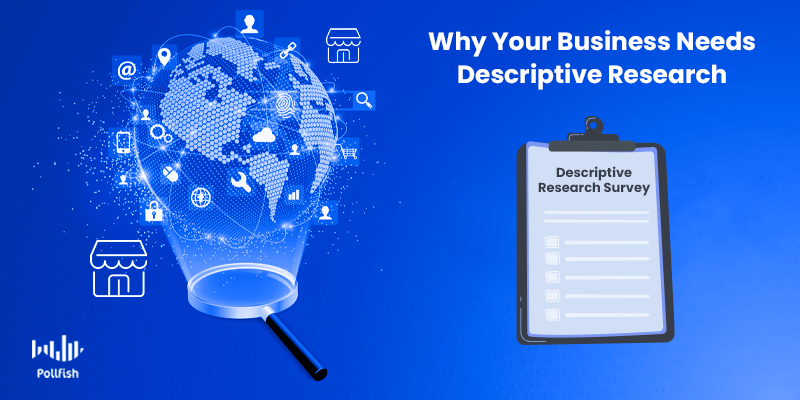
Businesses need descriptive research for a variety of reasons. Firstly, it provides additional information about a topic, with details that exploratory research alone cannot. Dovetailing to this is the fact that descriptive research is still a part of the early stages of a research campaign, as it does not explain the “why” around a problem.
Businesses benefit from this research as it is used to measure the opinions, attitudes of your current customers and potential ones, i.e., those in your target market. You can also gather information about their behaviors to help you segment them.
In addition, the information acquired through descriptive research can be used for advanced data analysis that allows business owners and marketers to draw conclusions, segment audiences, measure trends, and make well-informed decisions on how to move forward.
Several common descriptive research surveys include the following list. You’ll notice that these deal with differing topics and purposes, though still fall under descriptive research. As such, descriptive research helps businesses better understand their customers, their employees, their communities and much more.
Descriptive Research Survey Examples
- The NPS survey (Net Promoter Score)
- To understand how likely your customers will recommend your brand or particular product or service.
- The cross-sectional survey
- Studies a particular population at one particular point in time.
- Can help confirm or disprove a hypothesis of, for example, shopping behavior during an ad campaign.
- The community survey
- Ideal for brick and mortar businesses seeking to understand their community and community needs better.
- The employee feedback survey
- Sets the scene on employee sentiment and satisfaction with a business.
- Useful during mergers, acquisitions, growth spurts or simple quarterly reviews.
- The Product satisfaction survey
- Focuses on the product side of a business.
- Helps you business understand how your product is being received, including the presence of any glitches.
How Descriptive Research Differs from Correlational, Exploratory and Experimental Research
Descriptive research differs significantly from the other main types of research methods known as exploratory and correlational research.
Descriptive research is commonly confused with exploratory research. While these two research methods both involve the initial studies of a research process along with identifying a problem or situation, they differ significantly.
Exploratory research provides information about a problem the researcher faces. It is usually the very initial research method researchers turn to. Alternatively, descriptive research pursues describing something, such as its characteristics and functions.
An exploratory research campaign provides the underpinning of upcoming research (usually descriptive research) to discover if the subject of study can be explained by a theory. Unlike descriptive research, exploratory research is not conclusive, as it is not concerned with stats and quantifying data.
Descriptive research, on the other hand, is conclusive in nature, as it is primarily quantitative and focused on forming statistics. It is also rigid and structured, while exploratory research is flexible and unstructured.
Correlational research differs from descriptive research in that it is designed to uncover relationships among variables to see how one may affect another or others.
Additionally, the results of correlational research are used to make predictions of future events from present insights.
On the contrary, descriptive research seeks to create a snapshot of a studied subject and does not involve testing variables, whereas correlational research does and is primarily involved with exploring the relationships between variables.
Experimental research is, like its name implies, highly experimental, as opposed to purely observational, such as descriptive research. Essentially the complete opposite of descriptive research in several regards. Firstly, it is related to correlational research, as it studies relationships between variables, but it takes this concept a step further.
Secondly, it works by interfering with variables. Experimental research involves manipulating variables to come to a conclusion or finding. Unlike descriptive research, it is usually conducted in the final stages of a research project.
Piggybacking off of correlational research, it seeks to find the cause and effect of causal relationships, the kind that correlational research would discover.
Additionally, unlike descriptive research, which answers “what is,” experimental research answers “what if.”
The Advantages and Disadvantages of Descriptive Research
Descriptive research has various advantages for business owners and researchers alike. However, as with any research method, there are a few drawbacks to keep in mind as well.
The Advantages
- Grants a relatively complete illustration of what is occurring at a given time.
- Quantifies and analyses non-quantified issues and subjects.
- Observes a situation naturally, allowing for the observation of variables in their natural environments.
- The least time-consuming quantitative initiative.
- Can use both quantitative and qualitative research techniques.
- Can be used to create new hypotheses, delve into hypotheses and hypotheticals and create new research questions.
- Provides an extensive view of a topic, finding gaps and unknown details.
- Defines and measures data trends.
- Comparisons, ex: how various demographics react with the same and different variables.
- Offers unique data collection, i.e., it can exist in the forms of:
- examining life experiences
- reports
- case studies (including personal accounts of participants)
- surveys
The Disadvantages
- Cannot determine cause and effect relationships, or the causes behind any phenomena.
- Falls prey to survey bias, as respondents may answer questions with answers that are more desirable or in line with social norms.
- Bias can also occur from the researchers’ end when they frame the questions to fit a certain narrative.
- Leaves scarce room for diversity in answers since the question types of descriptive research are close-ended.
Excelling in Descriptive Research
With all the various research types available, it is key to find the most appropriate type for your needs. Descriptive research is invaluable to use in the early stages of your research around a topic, however, it is not the earliest kind to incorporate.
It usually follows exploratory research, which lays down the foundation of a research project, including hypotheses and curiosities that descriptive research can further probe. As there are many ways to conduct descriptive research, researchers need to find concrete means for conducting them.
Surveys are a relatively quick and accessible method for carrying out descriptive research. A strong online survey platform will facilitate the descriptive research process.
How Global Surveys Offer Optimal Research Across Geographies
How Global Surveys Offer Optimal Research Across Geographies
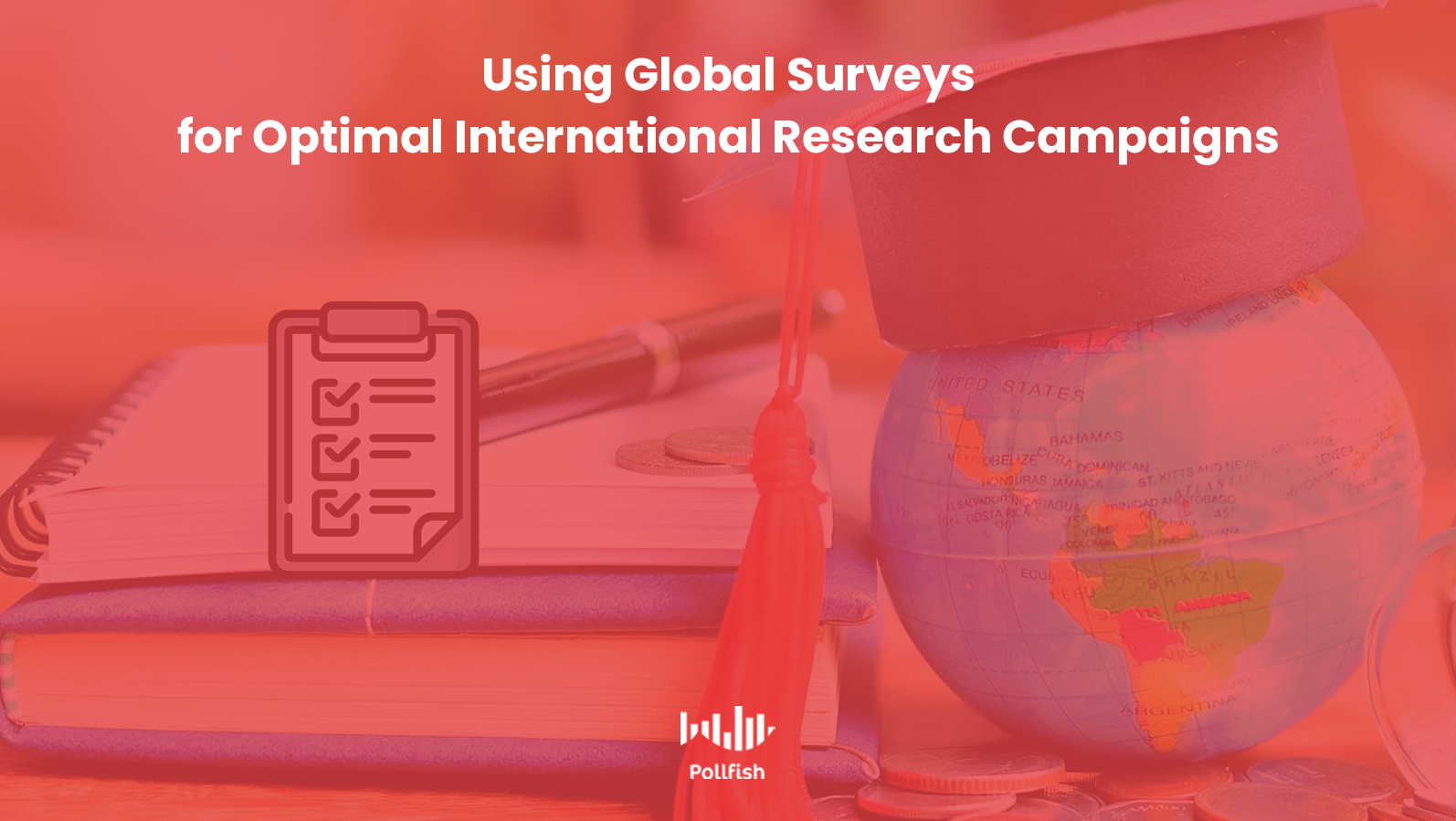
How Global Surveys Offer Optimal Research Across Geographies
In order to conduct research on an international scale, researchers must implement global surveys in their studies.
These surveys allow researchers to amass insights from virtually every geographical location in an efficient way — should the online survey platform that houses them allow it.
With global surveys, businesses and general researchers can understand the attitudes, opinions and habits of those living outside of their country.
It is particularly useful to implement global surveys when conducting a study for thought leadership, given that it arms brands with original data to use in their content marketing strategy. However, they can be used for a number of different purposes.
This article explores global surveys, their use and importance, and how a platform that offers global support and capabilities tailored for global studies will best suit any business. Additionally, this article provides a Pollfish use case for a major study using global surveys.
Understanding Global Surveys
Like their name suggests, global surveys are surveys designed for an international audience and deployed across different countries and continents.
These surveys are developed to gather information from different geographical markets and can be used to compare and contrast the intelligence garnered from surveys deployed domestically.
Global surveys allow businesses to understand their international customers, an increasingly important need, given that most businesses sell online and can therefore be found by those across geographical locations.
These surveys also allow businesses to understand pressing issues across the world and see how the opinions of those issues differ across countries. Thus, this kind of intelligence allows businesses to extract unique data which they can use in their marketing efforts.
Global surveys can be used for major research undertakings, such as the study on stress and smoking rates in low to middle income countries. This study was conducted across 41 countries with a survey sample of 217,561 people. Global surveys provided a strong global reach, along with launching cross-sectional studies and using the results to form prospective studies.
Global studies can also be used for smaller research projects, such as those that only focus on one country abroad or a handful. They can be used on one aspect of a marketing campaign, such as gathering sentiment around a new ad campaign.
The Value and Importance of Global Surveys
These kinds of surveys lend themselves to various research projects, as there are many directions a research endeavor may take.
For example, a business that wants to gain more online traffic from the southwestern region of the US may discover a new segment of their target market: site visitors from a nearby country, such as one from the Caribbean. If this traffic becomes significant, the business ought to conduct primary research into that segment.
In this way, businesses can also seek to branch out into further markets, such as those in Europe or Asia. In order to do so, they would need to extract insights on their global target market, i.e., the segment of the population most likely to buy from a company.
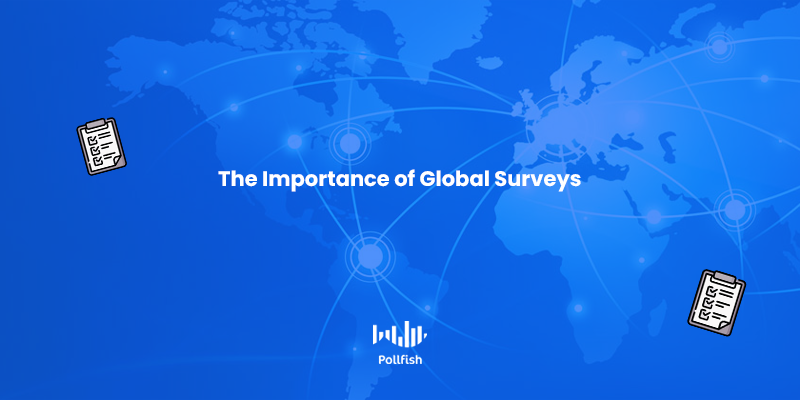
The same concept applies to businesses with an international presence; they may discover physical visits from those outside of a country (i.e., tourists) or digital visits from other countries.
Aside from this sort of perspective, global surveys bring other kinds of value and importance for a variety of studies. The following lists the ways these surveys are both practical and advantageous.
- They can be applied to all six of the main types of research
- This involves retrospective, cross-sectional, longitudinal and perspectives studies.
- They provide ease of access to segments that would be otherwise unreachable.
- This is especially the case for mail-out surveys and phone interviews, which would be far more expensive and difficult to execute.
- A study run by these surveys may reveal results that can apply, or at the very least, be tested on similar target demographics in the domestic sphere.
- They can be used as instruments of comparisons for the same demographics that live in different countries.
- Ex: Irish American middle-aged men versus Irish middle-aged men living in Ireland
- They help cater to the individuality of specific markets.
- They allow businesses to understand cultural matters in a firsthand way.
- They allow businesses to learn how those abroad view key events and products in their home country.
- They bring ambitious research projects in-house.
- They present a critical stage in market research for companies seeking to bring their business abroad.
- This includes keeping a business’s headquarters domestic, but shipping to other countries.
- They allow businesses to obtain international thought leadership.
All in all, international surveys ensure that businesses and researchers meet their international research goals.
How Global Surveys Were Used for a Major Research Project
Global surveys are often conducted for major research undertakings such as the Social Media & COVID-19 global study among Generation Z and Millenials, which was conducted as a joint study by the World Health Organization, two other organizations and performed entirely on the Pollfish platform.
In this global research study, surveys were deployed across 24 countries in an effort to understand how the younger generation consumes COVID-19-related news. As such, these surveys were used as a vehicle for understanding how fake news around a major topic forms.
The study wound up uncovering the presence of an “Infodemic,” that is, unproven claims, rumors and generally false information spreading about the coronavirus pandemic. The infodemedic was itself a kind of epidemic, as false information spreads at lightning speed online.
Thus, this global research study explored where Gen Z and Millennials get their COVID-19 news, who they regard as trusted sources and what their awareness levels are of fake news. Additionally, the study examined their COVID-related concerns and dug into the size of their social media accounts, including their likelihood of sharing unverified information.
This provided concrete information and data for two additional actors in this study: Wunderman Thompson and the University of Melbourne (Australia). This data provided marketing content for these two actors, which other brands can take advantage of, should they use global surveys from a robust online survey provider.
In order to forge strong global research and market research studies, the online survey platform that researchers use must provide various capabilities and relentless quality. The Pollfish whitepaper on the WHO Social Media and COVID-19 study provides a detailed look into how its platform did just that.
The Key Ingredients of a Successful Global Survey Study
In order to reap the benefits of global market research, there are several things researchers will need to apply in their global surveys. First off, the platform you use should allow survey deployment to virtually all countries.
You never know when you’ll need to study a specific geographic market, thus it is best to use a platform that offers an international reach.
The surveys should allow you to conduct the study in the language appropriate to the country (i.e., users) that they'll be sent to digitally. While researchers will be hard-pressed to find a platform that offers survey creation in all languages, it is key to be able to have access to numerous languages as opposed to merely English, Spanish and a handful of other most-spoken languages.
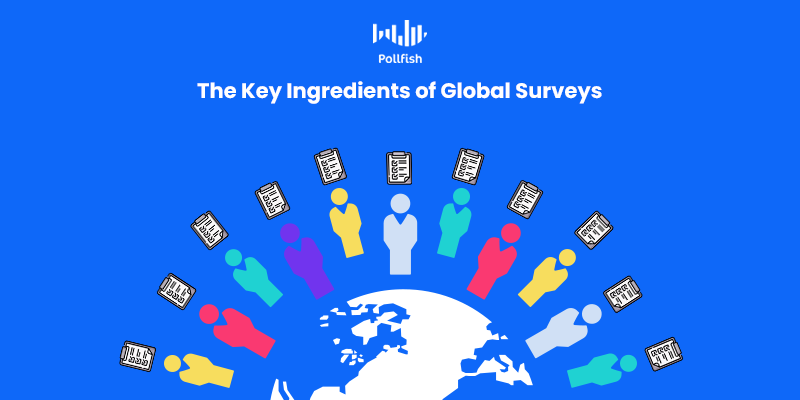
A strong online survey platform — such as Pollfish — offers researchers the capability of creating surveys in 46 languages.
Given that global survey campaigns can be difficult to organize, other aspects of the survey process must be simplified. For example, researchers ought to be given a reasonable completion time of their global surveys. This way, they’ll be aware of the approximate length of the survey and be able to execute time management.
Finally, there are the more technical aspects of the surveys that are just as important (if not more so) in a global campaign as they are in a national one. The surveys should offer relentless quality assurance.
These include offering a granular data filtering system, a mobile-first approach to the surveys in keeping with the current age SaaS integrations, applying the random device engagement (RDE) method to draw the most relevant and quality respondents and other features.
Relying on Continuous Global Support
Global surveys can help businesses gain insights to international markets for a vast array of purposes, whether it be for content strategy, gaining original insights, understanding another segment of your target market or other needs.
However, not all global surveys are built in the same fashion, thus, they don’t all offer the same capabilities. The power of these surveys rests in the online survey platform that hosts them.
Researchers must pay keen attention to all the functionalities of an online survey platform before deciding on the one that can provide optimal quality in global surveys and all matters pertaining to carrying out the research.
A suitable survey tool such as Pollfish, will offer global support, so that you can create, deploy and analyze global surveys with ease without incurring higher costs. Pollfish offers the same costs regardless of the surveys’ targeted countries, fielding research to 160 countries at scale and at speed.
Surveys are available in 46 different languages and include the Translate Survey feature, which makes reaching non-English speakers a seamless process.
Pollfish uses the random device engagement or RDE methodology, a top-notch method for extracting customer data by reaching global digital users in their natural digital environments; this includes some of the most visited websites and apps.
With global support offered around the clock and a strong online survey platform that uses machine learning to remove poor quality data, Pollfish is the most ideal survey platform.

